Bulletin – May 2005 Statement on Monetary Policy
Download the complete Statement 504KB
The global economic upswing is continuing in 2005 with growth being led mainly by the United States and China. In the US a broadly based recovery is now in its fourth year, and it has been accompanied by a gradual upward drift in core inflation. The rapid expansion in China has shown little sign of abating and other parts of non-Japan east Asia have generally been experiencing satisfactory growth. In contrast, the performance of the Japanese and euro area economies over the past year has been disappointing. Overall, while the world expansion remains geographically uneven, most official and private-sector forecasts at this stage are that world growth will continue at an above-average pace this year, though not as strongly as in 2004.
The Australian economy has for some time been operating with strong demand conditions and a high level of capacity utilisation. The December quarter national accounts continued the pattern of previous quarters, showing weak growth in GDP alongside above-trend growth in domestic demand. The outcome for GDP growth contrasted with a number of other indicators – in particular the rapid growth in employment and the favourable conditions reported in business surveys – which suggested that the economy had been growing strongly during 2004. As is often the case, it is not possible to find a neat reconciliation of these various sources of information. Nonetheless, it is clear from the national accounts that demand growth remained faster than average during 2004 but that, to a large extent, this was met by rising imports and declining inventories rather than by commensurate growth in output. This pattern is consistent with other indications that the economy has been operating at a level closer to full capacity than for some time, and that supply has been unable to keep pace with the growth of demand. A consequence of the gap between spending and production growth over recent years has been a widening of Australia's current account deficit, although other factors are also likely to have contributed including an appreciation of the exchange rate.
Indicators of economic conditions so far in 2005 suggest that the combination of firm demand conditions and high capacity utilisation continued in the early months of the year. The labour market remained firm in the March quarter, with employment posting further large increases and the unemployment rate remaining at its lowest level since the 1970s. Figures for retail sales showed a pick-up in the March quarter and other indicators of consumer demand such as motor vehicle sales and imports of consumer goods were up strongly in the quarter. Business surveys in the March quarter indicated softer conditions, though they generally remained well above average. The surveys also continued to report that businesses have been operating at high levels of capacity utilisation. In these circumstances it is not surprising that business investment has contributed strongly to the overall growth in demand during the past year, and indicators of investment intentions suggest that it will continue to do so.
An important influence on the economy at present is the boost to domestic income flowing from rising international commodity prices, particularly for mineral resources. Rising export prices boosted Australia's terms of trade by around 10 per cent during 2004, and a similar increase is likely to be recorded during 2005 as the recent round of increases in bulk commodity contract prices takes effect. This represents an important source of stimulus for the economy, with the current run-up in the terms of trade being the largest since the early 1970s. The rising terms of trade will boost demand and activity through a number of channels, including by providing ongoing encouragement to investment activity in the resources sector.
Much of the information on the domestic economy at this stage predates the March decision to increase the cash rate. Information on the impact of the cash rate increase is still quite limited, although there are some early signs that it is starting to have a dampening influence on demand. Consumer sentiment according to the Westpac-Melbourne Institute survey declined sharply in March, and showed only a slight pick-up in April. To keep this in perspective, sentiment is still above average, having come down from near-record levels earlier in the year. In the business sector, the monthly NAB survey indicated that conditions declined a bit further in March. In the housing market, the indications are that conditions have remained subdued in recent weeks. Overall, while the available evidence is still tentative, it is possible that the most recent tightening could have a larger short-term impact on spending and sentiment than has typically been the case in the past.
Drawing these various pieces of information together there is some evidence to suggest that domestic demand is now in the process of slowing from the above-average pace seen in 2004. However, given the generally favourable environment for business investment and ongoing stimulus to incomes from the rising terms of trade, any slowing in demand from last year's pace at this stage seems likely to be relatively mild.
Financial markets have undergone a substantial change in direction during the period since the February Statement, notwithstanding the generally positive global outlook described above. The change in sentiment was evident most clearly in equity markets though to some extent also in money and bond markets. During February and early March, rising confidence about growth prospects for the world economy was reflected in further strength in global equity markets. Thereafter, however, market sentiment began to weaken on concerns that the further step-up in oil prices would hold back world economic growth. These concerns were subsequently reinforced by some US data releases which, while solid, were less than the rather optimistic expectations embodied in market prices. World equity markets, including the Australian market, have since weakened by around 5 per cent. These market fluctuations may, of course, represent an over-reaction to short-term movements in the economic data, but it is possible that they are signalling some genuine easing in the pace of global expansion since the March quarter.
Global bond yields also rose over the February/March period but, like share markets, have since retreated. The Federal Reserve has continued on its well-telegraphed path of gradually normalising interest rates, with tightenings in March and early May. In Australia, the early March tightening, which lifted the cash rate by 25 basis points to 5.5 per cent, had been fully anticipated and its announcement caused little reaction in markets. Expectations of a further rate rise persisted for a time but have since receded, in line with the broader change in market sentiment.
Increases in global commodity prices, combined with strong demand conditions domestically and capacity constraints in some parts of the economy, have contributed to significant upstream price pressures in Australia during the past year. This was particularly evident in the second half of 2004, when producer price indices accelerated at all stages of production. In the March quarter these pressures appeared to ease off somewhat. Nonetheless, over the past year rapid increases in producer prices have been observed in areas that are closest to capacity limits, notably in the construction sector, and in products that are highly sensitive to rising raw materials costs such as steel and plastics.
Consumer price inflation has been relatively steady over recent quarters at an annual rate of around 2½ per cent. In the March quarter, the annual CPI inflation rate was 2.4 per cent, with underlying measures also close to that figure. For some time, underlying CPI inflation has been held down by the lagged effects of the exchange rate appreciation that took place during 2002 and 2003, while domestically sourced inflation has been higher. Given the pick-up in upstream prices over the past year and the waning of the drag from exchange rate effects, underlying inflation remains likely to increase gradually in the period ahead. However, if domestic demand pressures ease appreciably, it is possible that increases in upstream costs will to some extent be absorbed into profit margins rather than flowing into consumer prices. Taking these factors into account, the Bank's forecast is that underlying inflation will increase gradually from its current level to around 3 per cent by the end of next year. This is broadly the same as the forecast presented in the February Statement, although the upside risks to this forecast identified in February may have receded. In the short term, headline CPI inflation will be pushed higher than underlying measures by the recent increases in petrol prices.
Financial conditions at this stage do not seem to have been inhibiting the growth of credit and spending, although it is too early yet for the available credit data to reflect any impact from the recent policy tightening. The March tightening, in conjunction with earlier adjustments in 2002 and 2003, has brought the cash rate to a level that is broadly in line with its average over the low-inflation period since the early 1990s. Interest rates of financial intermediaries are still a little below average, as a result of margin compression during that period. Over recent months household credit growth has been fairly steady at around 1 per cent per month, or an annual rate of around 13 per cent, which is still strong by historical standards though down from the peak reached in 2003. At the same time, business credit growth has been gradually strengthening.
The Board's decision to increase the cash rate in March was taken against the background of strong demand pressures combined with a significant pick-up in upstream prices during the second half of 2004. As had been set out in the February Statement, consumer price inflation was forecast to increase gradually to the top of the target band, with the risks to that forecast judged to be weighted to the upside.
The information becoming available since March has provided some limited evidence that demand pressures are now easing, though whether this will be sufficient to contain inflation to an acceptable level still remains to be seen. At its April meeting the Board considered the case for a further tightening but decided to wait for additional information on inflation and for early indications of the impact of the March decision. In the event, March quarter prices data indicated that upstream price pressures had eased somewhat and that consumer price inflation remained relatively contained. Other information taken into account at the time of the May meeting included the shift in sentiment in financial markets. At the same time, it was recognised that the global expansion and rising terms of trade would provide ongoing support to the Australian economy in the period ahead.
The Board's assessment of this information at its May meeting was that inflation remained likely to increase gradually from its current level of around 2½ per cent, but that upside risks to this forecast had receded, partly as a result of the March tightening. This assessment of course remains subject to review as new information becomes available. Based on previous cyclical experience, it would be surprising if interest rates did not have to increase further at some stage of the current expansion. Nonetheless, given the tentative signs of easing in domestic demand pressures, the Board judged that there was a case to hold the cash rate steady for the time being, to allow further time to assess the strength of inflationary pressures. The Board will continue to monitor developments and make adjustments to the policy setting as required to ensure that Australia's economic expansion is not jeopardised by rising inflation.
International Economic Developments
The global economic expansion continues, and while the pace has eased since last year, the latest IMF forecasts are for world growth to remain comfortably above trend in both 2005 and 2006 (Table 1). The expansion remains geographically uneven, with disappointing growth in the euro area and Japan being offset by strength elsewhere, particularly in the US and China. However, world GDP growth is expected to become more synchronised in 2006 as activity increases in both the euro area and Japan.
| 2003 | 2004 | 2005 | 2006 | |
|---|---|---|---|---|
| IMF forecasts (April 2005) | ||||
| United States | 3.0 | 4.4 | 3.6 | 3.6 |
| Euro area | 0.5 | 2.1 | 1.6 | 2.3 |
| Japan | 1.4 | 2.7 | 0.8 | 1.9 |
| China | 9.3 | 9.5 | 8.5 | 8.0 |
| Other east Asia(b) | 3.8 | 5.8 | 4.5 | 5.1 |
| Australia's trading partners(c) | 3.3 | 4.8 | 3.7 | 4.0 |
| World | 4.0 | 5.1 | 4.3 | 4.4 |
|
(a) Aggregates weighted by GDP at PPP exchange rates unless otherwise specified
Sources: CEIC; IMF; RBA; Thomson Financial |
||||
The strength in global growth has been associated with a rapid expansion of trade and sharp increases in commodity prices and freight charges (for further details see ‘Box A: Developments in World Trade’). The pick-up in oil prices has been especially noteworthy, with the price of West Texas Intermediate crude oil rising to a new daily record of over US$57 per barrel in April, before falling back to around US$50 per barrel in early May (Graph 1). The strength in oil prices over the past year is a reflection of tight supply and strength in global demand, and the increases that occurred in 2004 so far appear to have had only a modest negative impact on global activity and relatively limited effects on inflation. However, recent movements in long-dated futures prices suggest market participants believe the recent run-up in oil prices will be more persistent than they did six months ago. Futures prices generally move somewhat in response to changes in the spot price, even when movements in the latter are driven by transitory factors, but their substantially lower volatility suggests that they are more anchored to longer-run price fundamentals than are spot prices. While spot prices in April were at levels comparable to those seen in October 2004, long-dated futures prices were close to US$10 per barrel higher than in October last year, at around US$48.
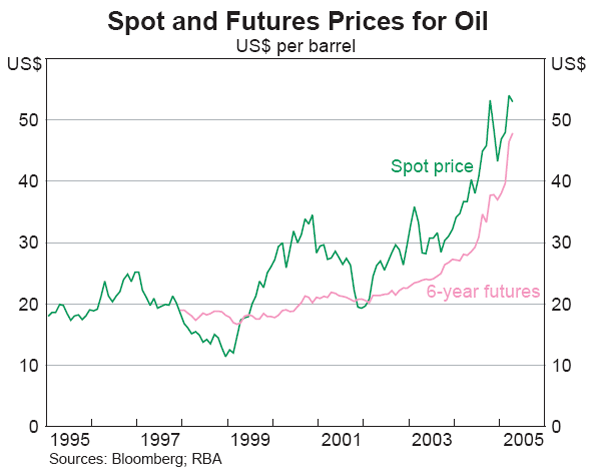
United States
The strong economic growth of recent years has continued into 2005. Real GDP increased by 0.8 per cent in the March quarter, to be 3.6 per cent higher over the year (Graph 2). Demand growth in the quarter was driven by consumption and equipment investment; some of this demand was met from abroad, as imports continued to expand at a faster pace than exports.
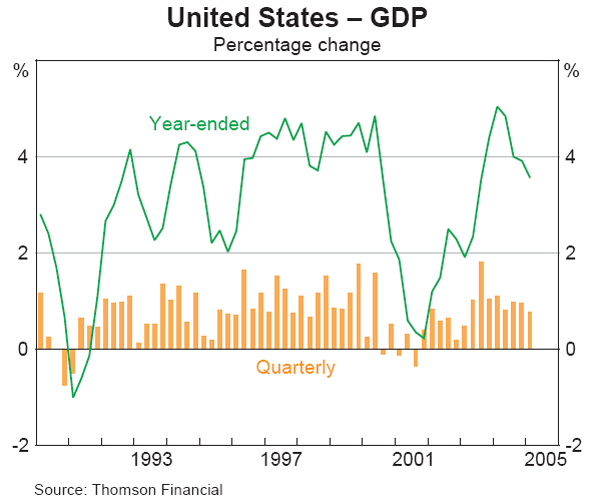
There has been ongoing improvement in the labour market, with an average of around 160,000 jobs added per month since mid 2004, somewhat above trend growth in the labour force (Graph 3). The unemployment rate fell to 5.2 per cent in March, down from a peak of 6.3 per cent in mid 2003. Nonetheless, it is likely that considerable slack remains in the labour market, with the participation rate remaining well below the level of earlier years and little sign of upward pressure on wages. Forward indicators of the labour market remain reasonably positive. Initial jobless claims are around 320,000, a level usually associated with monthly employment gains of more than 200,000, and the employment components of the ISM surveys report healthy labour demand.
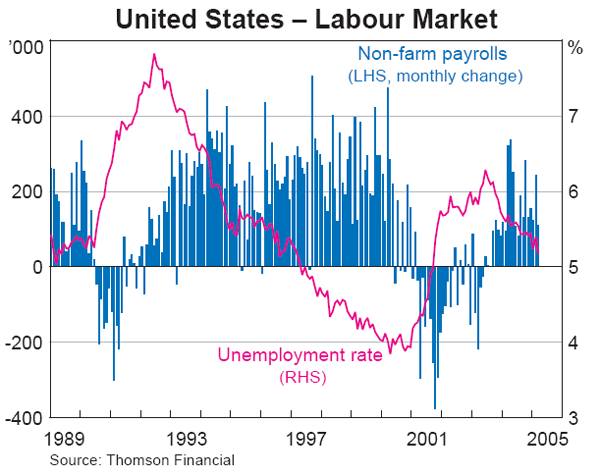
Consistent with the continued labour market recovery, consumption growth remained robust at 0.9 per cent in the March quarter, and 3.6 per cent over the year. Consumption was also supported by an increase in household net wealth in the December quarter of 4.2 per cent, driven by a substantial increase in the value of equities and rapid growth in house prices. Consumer sentiment remains around long-run average levels, despite declining a little recently.
Conditions in the business sector remain positive, with most measures of business sentiment remaining above trend. Corporate profits are very large as a share of GDP, having increased by 13.5 per cent in the December quarter, after being adversely affected in the previous quarter by hurricane-related losses (Graph 4). Combined with low gearing and favourable external financing conditions, this has underpinned a substantial increase in business investment of 11.1 per cent over the year to the March quarter, with particularly strong growth in investment in ITC equipment. Growth in core capital goods orders and shipments remains solid, pointing to continued growth in equipment investment in the period ahead.
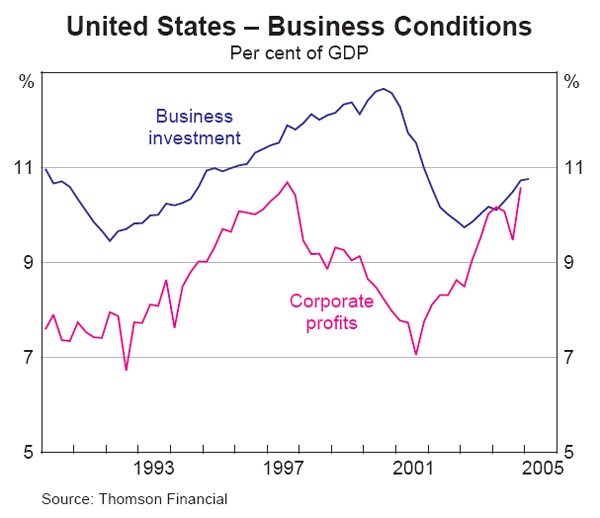
The robust pace of spending by US households and businesses saw the current account deficit widen further in the December quarter, reaching 6.3 per cent of GDP. This trend continued in the March quarter, as import volumes grew by 3.5 per cent and export volumes by 1.7 per cent.
Core inflation has drifted higher over the past year, as slowing productivity growth has pushed up growth in unit labour costs, albeit from a very low level. Having reached a trough of around 1 per cent in late 2003, core CPI inflation (which excludes the volatile food and energy components) increased to 2.3 per cent over the year to March (Graph 5). Core inflation as measured by the chain price index for personal consumption expenditure was more subdued, at around 1¾ per cent over the year to March. Upstream price pressures have increased; producer prices are rising strongly and the prices component of the manufacturing ISM survey has increased sharply in recent months. Accordingly, the Federal Reserve has continued its process of normalising interest rates, raising the funds rate by 25 basis points in both March and May, bringing the rate to 3.0 per cent.
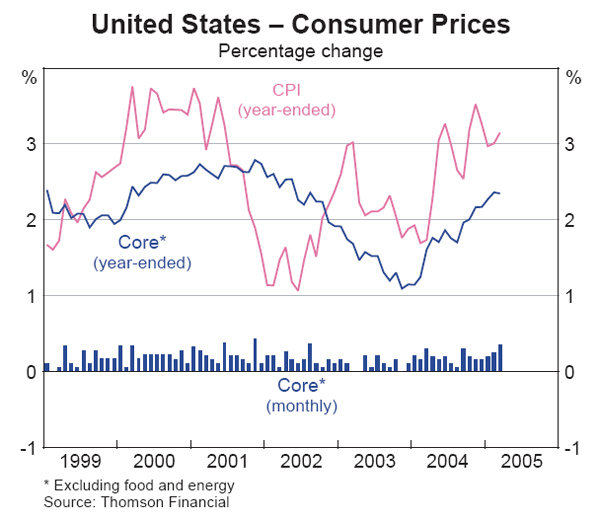
Asia-Pacific
Japan
The Japanese recovery lost momentum during 2004, with real GDP contracting for a period and growing by only 1.0 per cent over the year as a whole (Graph 6). Some of this faltering in growth can be attributed to special factors, such as the typhoons and earthquake that occurred in late 2004. Part of the slowing has also been associated with the downturn in the global ITC cycle in the second half of 2004. It is possible, however, that the national accounts data are overstating the weakening of the economy, given their susceptibility to extensive revision, and the fact that other indicators show greater strength.

Industrial production increased by 2.1 per cent over the year to March, with solid growth in production in non-ITC sectors offsetting weakness in ITC goods. But while the ITC downturn has tempered growth in production and export volumes, the outlook for overall economic activity is reasonably positive, with business investment in particular likely to strengthen. Business sentiment indicators, such as the PMI and the Shoko Chukin survey, have improved since the start of the year and are at above-average levels, and firms report high rates of capacity utilisation (Graph 7). Machinery orders rose strongly in February and growth in capital goods shipments remains solid. The corporate sector appears to be well-placed to fund ongoing capital spending, with corporate profits increasing by 13 per cent over the year to the December quarter and profit margins at their highest level in over a decade.
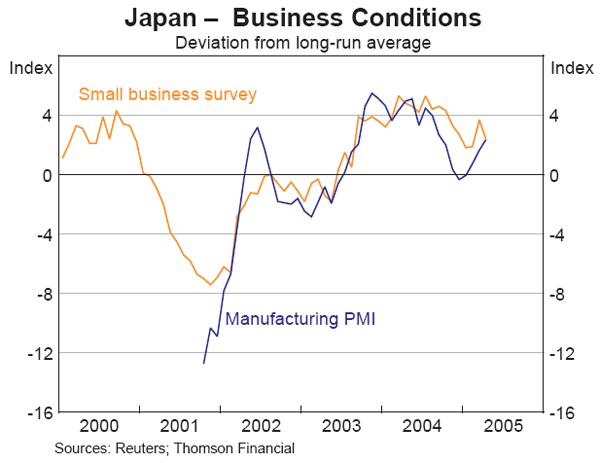
The outlook for household spending is also positive. Retail sales and consumer goods shipments have increased solidly in the latest quarter, and consumer confidence is relatively high, underpinned by more favourable employment prospects. Employment continues to expand at a modest pace, with payrolls up by 0.5 per cent over the year to March. Leading indicators of employment suggest further growth in the near term. The ratio of job offers to applicants and hiring intentions from various business surveys are at high levels. And while the downward drift in Japan's unemployment rate partly reflects the reduced participation of an aging population, at 4.5 per cent in March, the unemployment rate was at its lowest level in the past six years, consistent with increases in labour demand.
Deflationary pressures persist, though the GDP deflator suggests that they have lessened, with the year-ended rate of deflation easing from 1.7 per cent in the June quarter to 0.4 per cent in the December quarter. Consumer prices (excluding fresh food) fell by 0.3 per cent over the year to March; while this follows a period in which consumer prices had been stable, one-off factors that raised prices earlier have dropped out of the year-ended calculation. The influence of high prices for oil and other commodities is evident in the domestic corporate goods prices index, which was 1.4 per cent higher over the year to March.
China
The Chinese economy continues to advance at a rapid pace, providing significant impetus to growth in the rest of the east Asian region. Real GDP grew by 9.5 per cent over the year to the March quarter, the seventh consecutive quarter of above 9 per cent growth, despite the authorities' continuing efforts to moderate and rebalance growth.
Activity indicators also point to continued strong growth. Industrial production expanded by 15.1 per cent over the year to March, up from 14.4 per cent over the year to December (Graph 8). Retail sales growth remains buoyant, at 13.9 per cent over the year to March, underpinned by strong growth in per capita incomes, with rural incomes boosted by higher prices for agricultural goods. And despite the notable easing in credit and money supply growth, to around 14 per cent over the year to March, growth of fixed asset investment remains very high, at 26 per cent over the same period. The authorities are aiming to slow investment growth to around 16 per cent in 2005. Even at this rate, the investment-to-GDP ratio will continue climbing to almost 50 per cent this year.
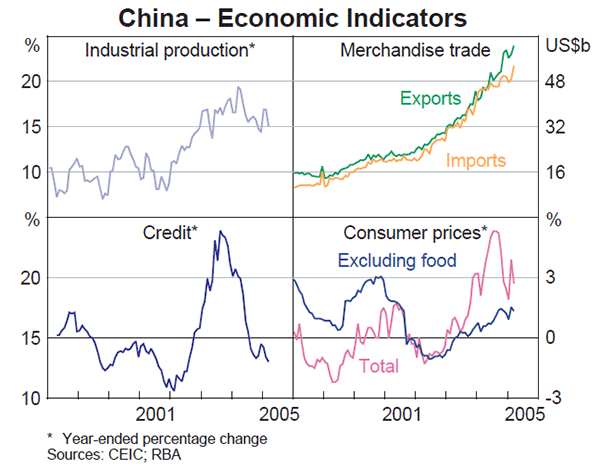
China's current account surplus has widened from 1½ per cent of GDP in 2001 to around 4 per cent of GDP in 2004. In the past few months, the trade surplus has widened significantly, as export growth remained rapid, at 33 per cent over the year to March, while import growth slowed to 19 per cent over the same period. Some of this easing in China's import growth may reflect reduced reliance on imports owing to the substantial expansion of China's manufacturing capacity in industries such as steel, automobiles and ITC. Notably, China's ITC trade surplus has swelled in recent months, as China moves from being a cheap assembly point for imported components to playing a larger role in the production process.
Upstream price pressures have subsided to some extent, with year-ended growth in the corporate goods price index of 3.5 per cent in March, down from 9.6 per cent in September last year. However, the recent large rises in world commodity prices may revive inflationary pressure, along with the emerging wage pressure in the major coastal regions where labour shortages exist. Consumer price inflation was 2.7 per cent over the year to March, up from 2.4 per cent in December. Excluding food, consumer price inflation is drifting higher, though it remains modest at around 1¼ per cent. Property prices rose by 9.8 per cent over the year to the March quarter, and there are signs of overheating in property markets on the eastern seaboard. The authorities have expressed concern about speculative activity, and have raised the effective minimum mortgage rate, and increased the minimum downpayment ratio in those cities experiencing the most rapid house price growth.
Other Asia-Pacific
The pace of growth in the rest of east Asia remains solid, though it has eased somewhat from the rapid rates of a year ago. GDP for the region expanded by around 4½ per cent over the year to the December quarter. At the country level, more pronounced slowing has been evident among the major ITC producers, such as Taiwan and Singapore (Graph 9). Growth has been firmer among the other south-east Asian economies, while after a subdued performance in 2004, there are some tentative signs of improvement in Korea's growth outlook.
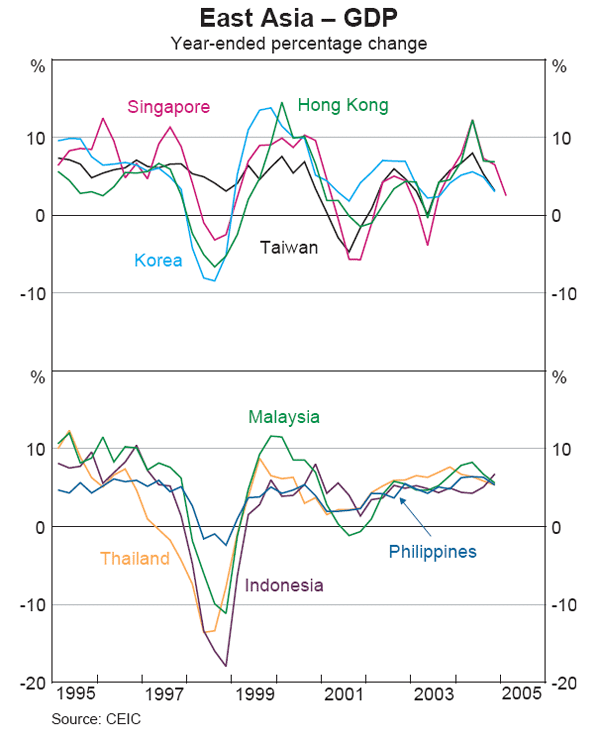
The contribution to growth from exports in east Asia lessened in the December quarter, in line with the downswing in the global ITC cycle. ITC goods account for a significant proportion of the region's merchandise exports, especially in Korea, Taiwan, Singapore and Malaysia. More recently, merchandise exports have increased modestly over the three months to March, and were around 12 per cent higher over the year. The impact of the ITC downturn is even more evident in the production data, where growth has slowed to a year-ended pace of around 3½ per cent, as firms cut back ITC production in order to rein in inventories.
There are, however, signs that the downturn in the ITC cycle may prove to be mild, with world semiconductor sales having risen since the beginning of the year to be well above levels of a year ago (Graph 10). A key factor supporting the recent increase in sales has been an avoidance of the large run-up in inventories that occurred in the 2000–01 dot-com boom. With world semiconductor sales now rising, it appears that much of the adjustment in the ITC sector may have already occurred.

The outlook for domestic demand in east Asia remains favourable. High levels of capacity utilisation, reconstruction activity in the wake of the south Asian tsunami and an improved investor climate in Indonesia should underpin growth in business investment. Retail sales continue to grow in most countries, buoyed by expansionary macroeconomic policies, strongly rising asset prices and improving labour markets. The unemployment rates in Hong Kong, Taiwan and Singapore have declined to around their lowest levels in about three years.
While Korea's recovery in domestic demand has lagged behind that in the rest of the region, recent developments have been more encouraging, with the process of household balance-sheet repair nearing an end. Households have reduced their indebtedness and increased their saving, and consumption growth in the December quarter was the strongest in over two years. Korea's improving prospects are also reflected in the noticeable lift in consumer and business sentiment since the beginning of the year (Graph 11).
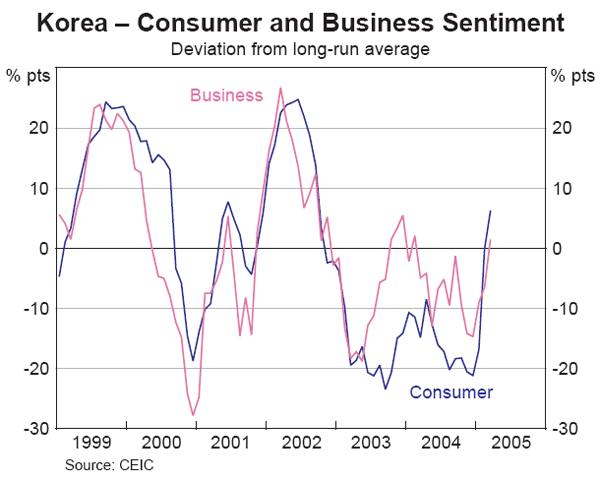
Headline consumer price inflation across the region continues to be affected by the high cost of crude oil and other commodities. This will be exacerbated in coming months as the governments of Indonesia, Malaysia and Thailand have implemented reductions in fuel subsidies. Underlying inflation in east Asia remains relatively contained, though is trending higher. Interest rates are still low in most countries, but the central banks of Indonesia, Taiwan, Thailand and the Philippines have raised policy rates in the past three months in response to mounting inflationary pressures.
In India, real GDP expanded by 6.2 per cent over 2004. Agricultural output subtracted from growth over the year as below-average rainfall reduced harvests, whereas non-farm GDP continued to expand strongly. More recently, manufacturing output has continued to grow strongly, but shortages of coal have restrained output in energy-intensive sectors so that growth in total industrial production slowed to 5 per cent over the year to February. Export growth has eased, but remains high at 23 per cent over the year to March. Price pressures have moderated in recent months, as the earlier run-up in raw materials costs has been partially unwound. The annual rate of increase in the wholesale price index eased to 5.0 per cent in March, down from the 8.7 per cent peak in August 2004. Nonetheless, the Reserve Bank of India raised its policy rate by 25 basis points in April to 5 per cent, noting high commodity prices and strong credit growth.
Economic growth in New Zealand remains strong, with GDP expanding by 3.9 per cent over the year to the December quarter. Growth has moderated somewhat from its rapid pace in early 2004, as activity in housing construction and consumer demand start to cool. Nonetheless, household spending continues to be supported by a strong labour market, with employment growing by 4.4 per cent over 2004 and the unemployment rate declining to an historically low 3.6 per cent. Consumer price inflation was 2.8 per cent over the year to the March quarter, near the top of the Reserve Bank of New Zealand's target band. The Bank raised policy rates by a further 25 basis points in March to 6¾ per cent, citing a stronger outlook for activity in the near term and associated pressures on inflation.
Europe
Growth in the euro area has remained lacklustre, reflecting subdued domestic conditions and the loss of impetus from net exports. GDP growth was 0.2 per cent in the December quarter and 1.6 per cent in year-ended terms (Table 2). Although there was a reasonable increase in domestic final demand in the quarter, stocks and net exports both fell. Performance at the country level was mixed: output contracted in Germany and Italy, while economic growth resumed in France and continued at a robust pace in Spain.
| September quarter 2004 |
December quarter 2004 |
Year to December quarter 2004 |
|
|---|---|---|---|
| Euro area | 0.3 | 0.2 | 1.6 |
| – Germany | 0.0 | −0.2 | 0.6 |
| – France | 0.0 | 0.9 | 2.3 |
| – Italy | 0.4 | −0.4 | 0.8 |
| – Netherlands | 0.3 | 0.0 | 1.2 |
| – Spain | 0.6 | 0.8 | 2.7 |
| United Kingdom | 0.6 | 0.7 | 2.9 |
|
Source: Thomson Financial |
|||
Industrial production in the euro area has also fallen short of expectations. Despite good growth around the turn of the year, a soft outcome in February left year-ended growth at 0.7 per cent (Graph 12). Similarly, declines in the manufacturing PMI in March and April unwound the gains in preceding months. These developments reflect the failure of domestic demand to stage a significant recovery, while export growth continues to slow, as the strong euro erodes competitiveness. Accordingly, business sentiment has declined in recent months, with most surveys now around long-run average levels. Nevertheless, the outlook for investment is positive; there was good growth in investment in the December quarter and favourable financing conditions and high corporate profitability should contribute to further increases in capital spending.
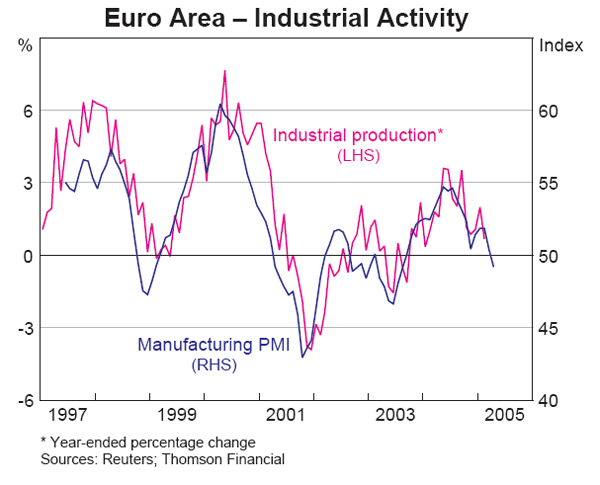
Household consumption was subdued in much of the euro area in the December quarter, though it picked up in France. This pattern has continued into 2005, with retail sales growing strongly in France and Spain, but remaining weak in Germany, despite the recent introduction of income tax cuts, and continuing to decline in Italy and the Netherlands. Housing market developments have been at the heart of the divergence, with a house price boom contributing to rising household wealth and an increased appetite for debt in France and Spain, while real incomes and house prices have been flat or falling in the other major euro-zone economies. Uncertainty about labour market reforms, the adequacy of pension systems and future economic conditions may also be discouraging consumers from spending, especially in Germany where these issues have received much publicity. Consumer confidence in the euro area eased in the past three months to be back around the level of October last year. The euro-wide unemployment rate has hovered just below 9 per cent over the past three months. Reflecting the sluggish labour market conditions, labour cost growth in the euro area remained low at 2.4 per cent over the year to the December quarter.
Inflation has remained around the ECB's 2 per cent reference level in recent months, holding steady at 2.1 per cent (Graph 13). Underlying inflation has declined from 1.9 per cent over the year to December to 1.6 per cent over the year to March, as earlier increases in administrative costs have dropped out. The ECB has continued to hold its policy rate at 2 per cent.

The pace of activity in the United Kingdom has slowed since mid 2004 as the housing sector responds to the earlier tightening of monetary policy. GDP grew by 0.6 per cent in the March quarter and by 2.8 per cent over the year, down from a peak of 3.6 per cent over the year to the June quarter 2004. Higher interest rates and the resultant cooling in the housing market have tempered domestic demand growth. Net exports have also weakened, with growth in exports slowing while import growth has remained firm, stimulated by the appreciation of the pound. Growth in manufacturing production has also eased. However, surveys suggest that business confidence remains at a high level, reflecting high corporate profitability.
The cooling in the housing market has progressed in an orderly fashion. According to the Nationwide and Halifax surveys, year-ended house price growth declined to around 8 per cent in March from 20 per cent in the middle of last year. Housing credit growth has fallen sharply in recent months, and housing equity withdrawal has declined to less than half of its peak in December 2003. Accordingly, retail sales have shown little growth since the middle of 2004. Nevertheless, consumer confidence remains high and the unemployment rate remains near generational lows.
Consumer price inflation has picked up over the past three months, to be 1.9 per cent over the year to March. Much of this rise is due to higher energy costs, and underlying inflation remains around 1¼ per cent. The Bank of England has held the repo rate constant at 4¾ per cent since August 2004.
Box A: Developments in World Trade
After only modest growth initially following the 2001 global recession, international trade in goods and services has rebounded strongly of late, increasing by about 10 per cent in 2004, or approximately double the rate of growth in world GDP (Graph A1). In large part, this reflects the tendency for trade to fluctuate by more than output. However, it also reflects the consequences of ongoing trade liberalisation, and changing demand for final goods and factor inputs as economies develop. The recovery in world trade has been propelled mainly by China and other east Asian economies, which are becoming increasingly engaged in international commerce (Table A1), and to a lesser extent other emerging economies. While accounting for only 5 per cent of world trade, China contributed approximately 15 per cent of the increase in trade in 2004 and became the world's third-largest merchandise exporter. In contrast, the G7 industrialised countries, despite accounting for nearly half of world trade, contributed only around a third of the increase in 2004.
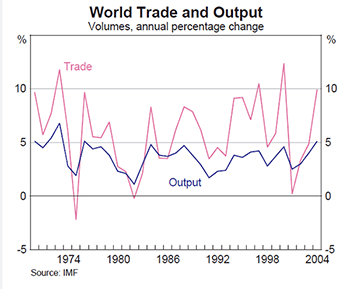
| World trade share |
Annual export growth | Annual import growth | ||||
|---|---|---|---|---|---|---|
| 2003(b) | 2003 | 2004 | 2003 | 2004 | ||
| G7 | 46 | 1.3 | 7.2 | 3.2 | 7.5 | |
| United States | 14 | 1.9 | 8.5 | 4.4 | 9.9 | |
| Euro area(c) | 31 | 0.1 | 5.8 | 1.8 | 6.0 | |
| Japan | 5 | 9.1 | 14.4 | 3.8 | 8.9 | |
| China | 5 | 27.7 | 28.8 | 22.2 | 28.3 | |
| Other east Asia(d) | 11 | 11.1 | 16.1 | 7.0 | 15.4 | |
|
(a) Aggregates weighted by GDP at PPP exchange rates unless otherwise
specified Sources: CEIC; IMF; RBA; Thomson Financial; World Bank |
||||||
The uneven contributions to growth in world trade in part reflect divergences in economic growth across regions. Hesitant demand growth in the euro area explains the modest growth of export and import volumes in the region, since intra-regional trade accounts for around two-thirds of the area's total trade.[1] In the United States, trade has been expanding somewhat faster, as strong domestic demand has induced ongoing growth in imports; exports have also staged a recovery, though not one that has been sufficient to arrest further widening of the trade deficit. Japan has seen yet stronger trade growth, with its trade surplus continuing to swell, underpinned by strong demand for its exports from the rest of Asia; most notably, its exports of intermediate and capital goods to China have been growing rapidly.
The east Asian region (excluding Japan) has undoubtedly recorded the most impressive trade performance. The surge in demand for ITC goods in 2003–2004 boosted the region's exports of manufactures, while the region's imports have accelerated as China increasingly calls on the rest of the world for raw materials to satisfy its ongoing process of industrialisation. There has also been a substantial change in the pattern of east Asian trade, with intra-regional trade growing in importance. In 2004, 37 per cent of east Asian merchandise exports went to economies elsewhere in the region, up from around 33 per cent five years earlier. This shift has been fuelled not only by increased final demand within the region, particularly from China, but also by a reorganisation of production processes into regional networks. Goods are increasingly being assembled in China from parts sourced elsewhere in the region, and then exported to developed countries. This largely explains why China has recorded growing trade surpluses with the US and Europe, but trade deficits with the rest of Asia.
The pattern of global trade has had major implications for the prices of traded goods and services. The emergence of China as a major producer has put downward pressure on the world price of manufactures. On the other hand, China's seemingly insatiable appetite as an importer of raw materials has contributed to the surge in world commodity prices, including oil. Consequently, commodity importers, such as east Asia, Japan and the United States, have experienced a deterioration in their terms of trade. In contrast, the rise in world commodity prices has been beneficial for commodity exporters, such as Australia and Canada, and a number of countries in Latin America and the Middle East.[2]
The strength of world trade and the shift in trade patterns can also be seen in global shipping freight rates, as shipping still accounts for around two-thirds of the value of all international goods transportation. In line with the pick-up in commodity demand, the Baltic Dry Index, which tracks freight prices for dry bulk goods, has soared to unprecedented levels over the past two years (Graph A2). Unsurprisingly, the pick-up in freight rates has been especially concentrated on trade routes to Asia, and the ports along these routes have become increasingly congested. Conditions are generally expected to remain tight, in part due to short-run inelasticity in the supply of ships and continued strong world activity.
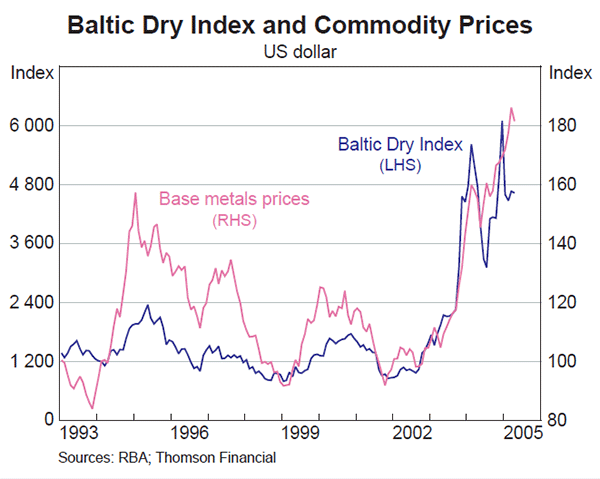
As with GDP growth, world trade activity is expected to ease, but remain healthy. The IMF projects world trade to grow by 7.4 per cent in 2005. However, the recent trend of greater involvement by emerging economies in international commerce is set to continue, with China and other east Asian economies likely to account for a growing share of world trade. This can be expected to have a positive influence on the Australian economy in coming years, given Australia's proximity to the east Asian region and the strong trade links that have been cultivated with it over the past decade or so.
International and Foreign Exchange Markets
Policy interest rates
Over the past three months, the US Federal Reserve has continued the tightening path it commenced in June 2004, raising the federal funds rate by 25 basis points at both its March and May meetings. This took the target rate to 3 per cent, up from 1 per cent a year ago (Graph 14). Until fairly recently, markets had been expecting that the Fed would maintain the 25 points per meeting tightening pace over the second half of 2005, and at one stage in March had even started to price in some moves of 50 basis points following the release of higher-than-expected CPI data. However, over April there was a noticeable shift in sentiment. Markets have scaled back their tightening expectations due to concerns that the US economy may be slowing. Currently, the Fed is expected to tighten further at only some of its remaining meetings this year.
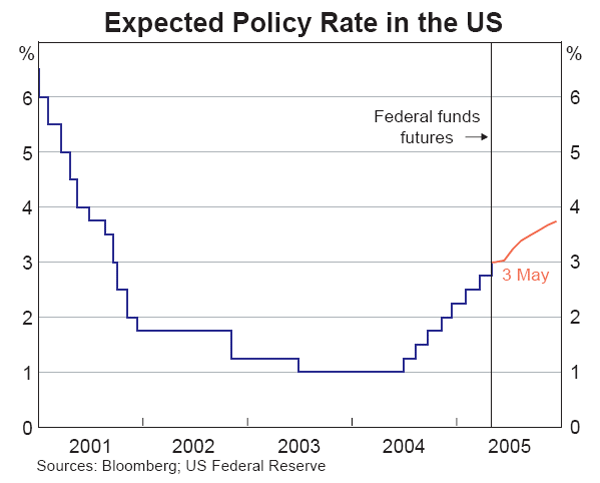
The European Central Bank (ECB) has not changed monetary policy for nearly two years, leaving its refinancing rate at 2 per cent (Graph 15). With continuing weak growth in the euro area, markets do not expect the ECB to begin lifting rates for some time. Similarly the Bank of Japan (BoJ) has left monetary policy unchanged for a substantial period, with the economy experiencing only moderate economic growth and continued, albeit less pronounced, deflation. However, the decision at each of the April meetings to maintain the current policy stance – expressed as a target for banks' excess reserves – was not unanimous, adding to speculation that the target may be reduced over coming months. Such an action would be more of a technical adjustment rather than a tightening of policy.
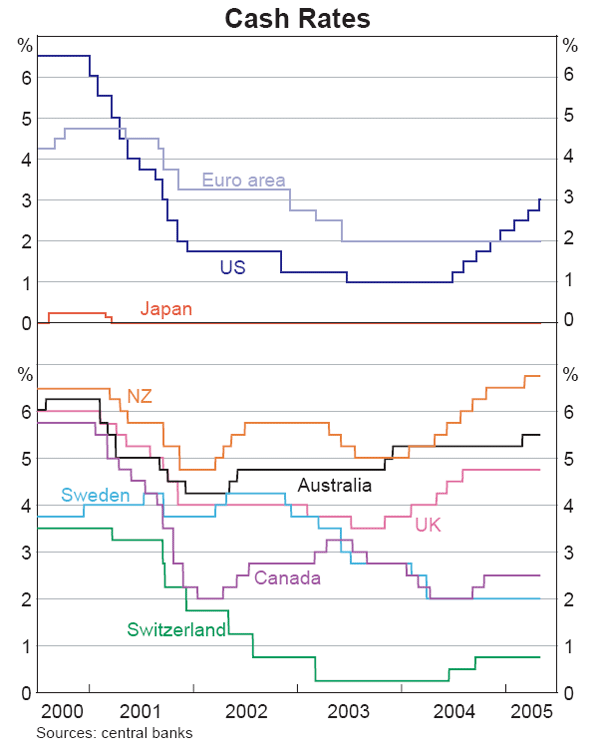
The central banks in the UK and Canada, which had been tightening in 2004, have not changed policy in recent months. Markets continue to attach some probability to rate increases in both countries over coming months, particularly in the case of Canada. The Reserve Bank of New Zealand raised its target rate by 25 basis points to 6.75 per cent in March, taking the cumulative increase since this tightening cycle began in early 2004 to 175 basis points.
In Asia, the Philippines, Taiwan, and Thailand tightened policy, citing inflationary pressures. Hong Kong followed its usual practice of announcing a 25 basis point rise in its cash rate following the US Federal Reserve's decisions to tighten. To address concerns about overheating in the property sector, the People's Bank of China (PBC) increased the minimum loan rate of a five-year mortgage from 5.31 per cent to 5.51 per cent. It also announced plans to increase the required deposit on property loans from 20 per cent of the loan value to 30 per cent in areas where property price growth has been deemed excessive. In Latin America, Mexico, Brazil and Chile all tightened monetary policy due to rising concerns about inflation. On the other hand, there has been a tendency towards lower interest rates in emerging Europe, with Turkey and a number of eastern European countries all easing policy due to declining inflation pressures. South Africa has also lowered interest rates in the past three months in part reflecting the large appreciation of the rand.
Bond yields
The level of bond yields in markets globally continues to be low by historical standards. While the low level of yields in Europe and Japan could perhaps be explained by the continuing subdued economic activity in these regions, most analysts have great difficulty explaining why 10-year bond yields in the US are lower now than they were a year ago, even though the Fed has tightened monetary policy by 200 basis points in the meantime. The level of yields – around 4¼ per cent at present – looks low not only on historical comparisons but also relative to normal benchmarks such as the growth rate of nominal GDP, which in the US is currently around 6 per cent (Graph 16).
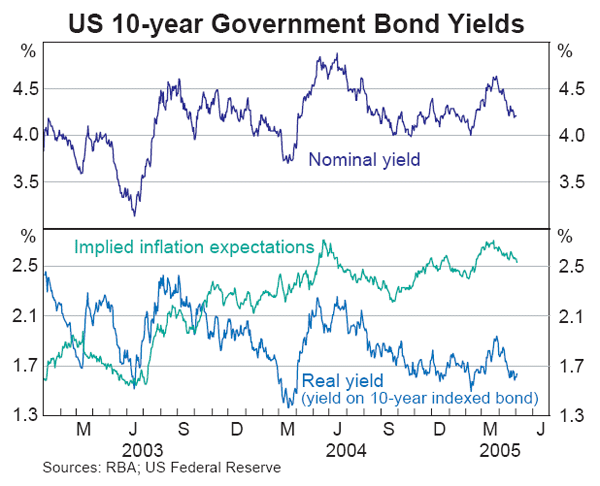
For a while in March it looked like the puzzle of low bond yields was disappearing, as yields rose noticeably to 4.65 per cent after a stronger-than-expected CPI result. But the rise has since been unwound, even though the following month also recorded an elevated CPI outcome. The reason for the recent decline in yields seems to be concerns that the US economy may be slowing, due in part to the renewed run up in oil prices.
German yields also rose in February, though by less than Treasury yields, and have subsequently fallen back to their lowest level in the post-War period (Graph 17). Reflecting further scaling back in the outlook for economic growth in Europe, the spread between US and German 10-year bond yields has widened. Yields on 10-year Japanese government bonds have also fallen back to be close to the lowest they have been in the past eighteen months.
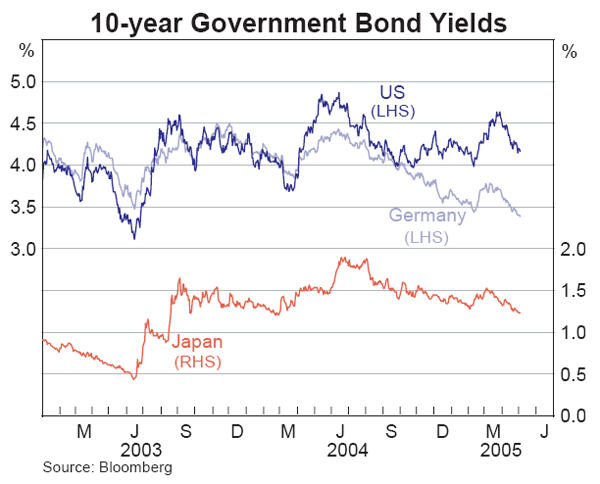
The reasons for the low level of yields, particularly in the US, have been the subject of a good deal of conjecture. Among the explanations that have been put forward are the increased credibility of central banks in controlling inflation (inflation rates remain below 3 per cent across the developed world), the low level of official interest rates in the major economies reflecting low inflation and the continuing weakness in some economies, a glut of savings on world markets particularly sourced from the Asian region, and changes to pension fund rules in some countries which are seen as biasing investments away from equities towards bonds. The fact that yields are low in the face of the large funding requirements resulting from government deficits in many major countries is seen as adding to the puzzle.
There are some tentative signs that investors have been scaling back their exposure to relatively risky assets (Graph 18). Spreads on US corporate ‘junk bonds’ have widened since the beginning of the year, mainly reflecting the downgrade by Moody's of General Motors' credit rating to just above ‘junk’ status, and the placement of Ford's credit rating under review. Spreads on B-rated junk bonds have increased by around 80 basis points since early February, while spreads on emerging market sovereign debt have also widened over the past three months, led by a 40 basis point increase in Latin American spreads. Nevertheless, spreads still remain at historically low levels.

Equity markets
Reflecting concerns that the robust pace of world economic growth may not be sustained, global equity markets have fallen in recent weeks (Graph 19, Table 3). The falls on US markets have been large enough to more than erase the gains that had occurred earlier in the year. Over the past three months, the S&P 500 has fallen by 2½ per cent, while the technology-focused NASDAQ has fallen by 7 per cent. Earnings reports from US companies for the first quarter were mixed. Market sentiment was not helped by General Motors announcing its biggest quarterly loss since 1992, and by the downgrading of its credit rating.
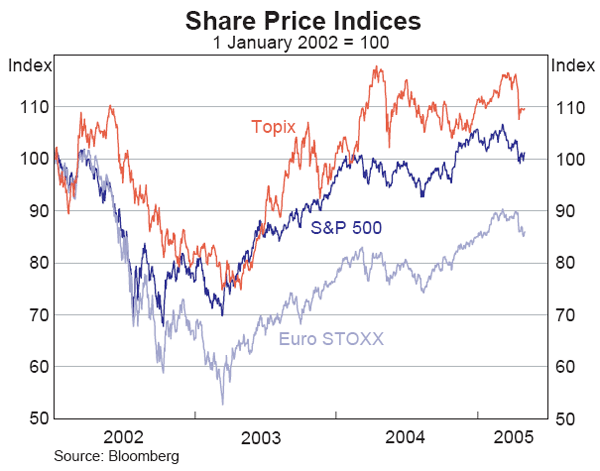
| Change since 2000 peak |
Change since 2003 trough |
2004 | 2005 to date |
|
|---|---|---|---|---|
| United States | ||||
| – Dow Jones | −13 | 36 | 3 | −5 |
| – S&P 500 | −24 | 45 | 9 | −4 |
| – NASDAQ | −62 | 52 | 9 | −11 |
| Euro area | ||||
| – STOXX | −42 | 64 | 10 | 1 |
| United Kingdom | ||||
| – FTSE | −30 | 48 | 8 | 1 |
| Japan | ||||
| – TOPIX | −36 | 47 | 10 | −2 |
| Canada | ||||
| – TSE 300 | −18 | 50 | 12 | 1 |
| Australia | ||||
| – ASX 200 | 18 | 48 | 23 | −2 |
|
Source: Bloomberg |
||||
In Japan, the TOPIX index has declined by 1½ per cent since the last Statement. Exporter stocks in particular declined in response to the perceived slowing in the global economy. The revelation that some companies had misreported earnings also raised concern about poor corporate governance. European stocks have declined over the period since the last Statement, though that market is still up a little in net terms for 2005 to date.
In line with the major markets, equity prices in emerging markets have also generally weakened in recent months. In Asia, concerns about the state of the ITC cycle contributed to the decline. A notable exception was China where stocks rose 4 per cent, supported by reports that the government may reduce its holdings in many listed companies. In Latin America, average share prices were also lower.
Exchange rates
The US dollar has traded in a relatively stable range against the major currencies over the past six months, following the broad-based depreciation that began in early 2002 (Graph 20). Concerns about the US current account deficit have been balanced by the fact that US growth prospects continue to be better than those in Europe or Japan, notwithstanding the recent concerns about a slowdown. The fact that US interest rates now clearly exceed those in Europe also seemed to support the US dollar. Speculative positioning suggests that sentiment towards the US dollar has become less negative. The large speculative short positions in the US dollar against other major currencies that were present earlier in the year have been scaled back significantly and, in some cases, speculators are now holding net long positions.
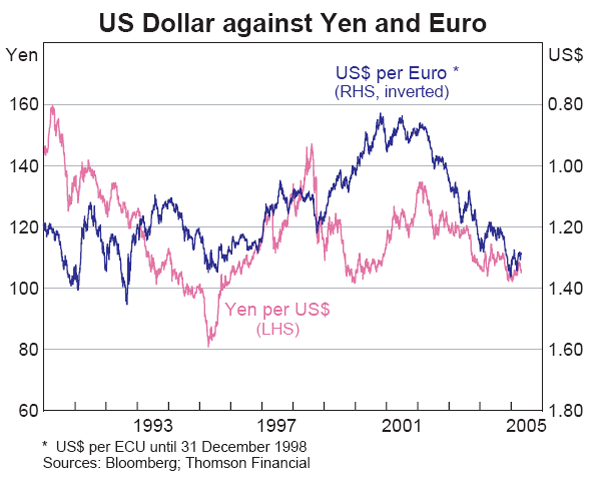
The attention of global foreign exchange markets in recent months has not really been focused on exchange rates among the major countries (Table 4). Rather, there has been more interest in the exchange rate arrangements of China, with speculation continuing about when it will free up its exchange rate arrangements. That China will, at some point, break its existing peg of 8.28 to the US dollar is now accepted in markets as being a certainty. The issues that are being debated are when this will happen and what type of arrangement will be put in place once the break is made.
| Since January 2004 |
2005 year to date |
|
|---|---|---|
| South Korea | 15.1 | 3.1 |
| Brazil | 11.4 | 5.5 |
| South Africa | 7.5 | −8.0 |
| Taiwan | 7.4 | 1.5 |
| New Zealand | 6.4 | 1.0 |
| India | 4.2 | 0.1 |
| Singapore | 3.3 | −0.3 |
| United Kingdom | 3.2 | −1.8 |
| Switzerland | 2.5 | −5.8 |
| Canada | 2.0 | −4.1 |
| Philippines | 1.8 | 3.6 |
| Japan | 1.4 | −2.1 |
| Euro area | 0.5 | −5.2 |
| China | 0.0 | 0.0 |
| Sweden | 0.0 | −7.8 |
| Malaysia | 0.0 | 0.0 |
| Australia | −0.3 | −0.8 |
| Hong Kong | −0.3 | −0.2 |
| Thailand | −1.4 | −1.3 |
| Mexico | −2.1 | 0.9 |
| Indonesia | −14.2 | −2.4 |
| US broad TWI | −1.6 | 1.6 |
|
Source: RBA |
||
Expectations of a change in exchange rate policy in China are expressed by market participants in the non-deliverable forward market, which is not controlled by the authorities. This market is currently pricing in an appreciation of 6 per cent over the coming year (Graph 21).
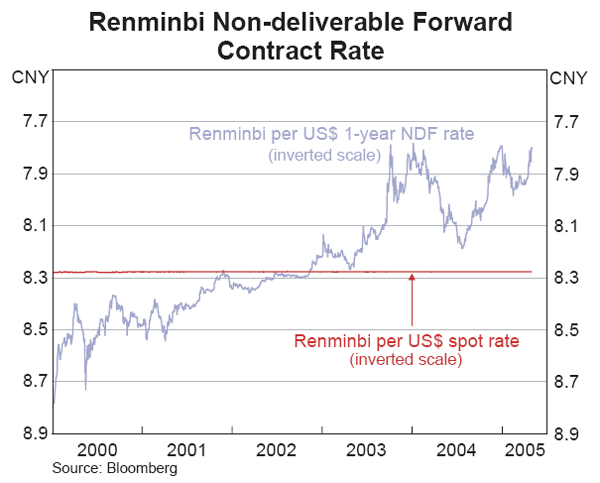
This focus on Chinese exchange arrangements is having a more general impact on exchange rates in the region, with most other regional currencies also facing upward pressure. Partly this is because markets expect that, if China revalues, other Asian countries may also let their currencies appreciate. Market participants are therefore using some of these currencies, which are more freely traded than the Chinese renminbi, as ‘proxy hedges’ for a Chinese revaluation. Against this background, Asian authorities have continued to intervene in foreign exchange markets, though less strenuously than was the case in mid 2004 when upward pressures on regional exchange rates were also very strong.
Australian dollar
Trading in the Australian dollar over the past three months has continued to be relatively uneventful. The exchange rate has been in a stable range between US75 cents and US80 cents, and 62 and 65 on a trade-weighted basis, over the past six months (Graph 22, Table 5). In early March, it reached the upper end of this range, much the same level as the peak a year earlier, against a background of, inter alia, strong domestic profit results, speculation of foreign takeovers, and rising commodity prices (especially base metals). The level of A$ Uridashi bond issuance during March was also sizeable, which added to demand for Australian dollars, though some of this was offset by the increased maturities of existing A$ Uridashi bonds (Graph 23). Since March, however, the currency has fallen back to around the middle of its recent trading range as the degree of optimism about commodity prices receded and on the expectation that interest rate differentials relative to the US would narrow.
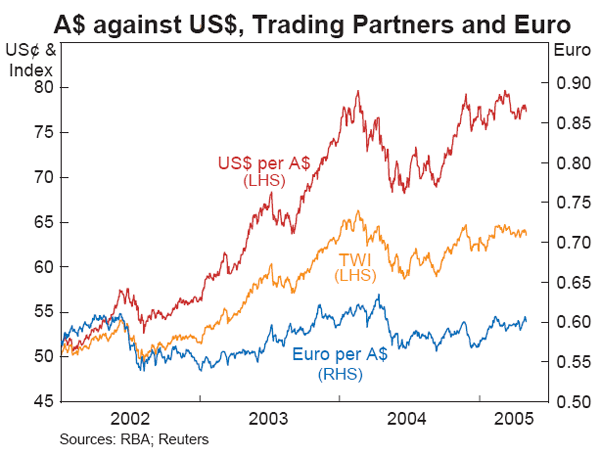
| Since January 2004 |
2005 year to date |
|
|---|---|---|
| Indonesia | 14.1 | 1.6 |
| US | 1.2 | −0.7 |
| Japan | 0.1 | 1.4 |
| Philippines | −2.1 | −4.3 |
| Sweden | −2.2 | 7.0 |
| Euro area | −2.5 | 5.0 |
| Singapore | −2.6 | −0.5 |
| United Kingdom | −3.0 | 1.0 |
| Switzerland | −3.8 | 5.0 |
| Canada | −4.7 | 3.4 |
| PNG | −5.2 | −1.2 |
| Taiwan | −5.3 | −2.2 |
| New Zealand | −6.6 | −1.7 |
| South Africa | −12.1 | 7.2 |
| South Korea | −13.8 | −3.9 |
| TWI | −1.6 | 0.5 |
|
Source: RBA |
||
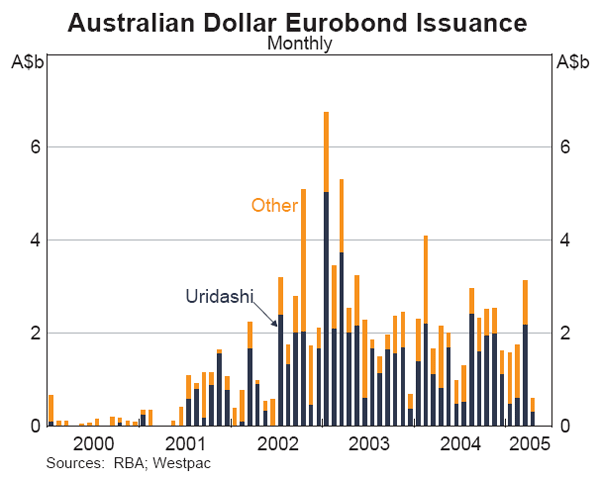
While market sentiment towards the Australian dollar remains positive, there has been a scaling back of speculative long positions in Australian dollar futures, albeit from high levels. However, the Australian dollar remains one of the few currencies in which market participants continue to have long speculative positions relative to the US dollar (Graph 24); in the case of the Japanese yen, Canadian dollar and Swiss franc, speculative positions against the US dollar are short.
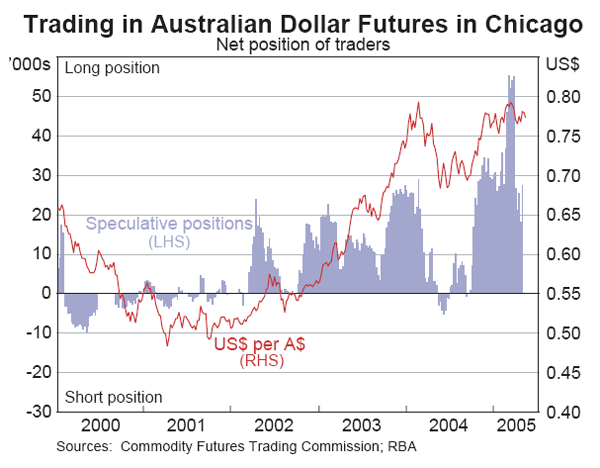
With the narrower trading range for the Australian dollar during 2005, exchange rate volatility has fallen below its post-float average. The implied volatility from Australian dollar options shows a similar easing in volatility in recent months.
As the Australian dollar appreciated against the US dollar and traded near the top of its recent range, the Bank took the opportunity to add around $1 billion to net reserves over the three months, though mostly in March. Overall, net reserves increased from just under $25 billion at the end of January to around $26 billion at the end of April. Over the same period, holdings of foreign exchange under swaps increased from $21½ billion to around $26 billion as the Bank continued to make use of foreign exchange swaps to help with domestic liquidity management.
Domestic Economic Conditions
Domestic final demand grew strongly during 2004, expanding by 1.0 per cent in the December quarter, and by 4.0 per cent over the year. Within the total, strong quarterly growth in business investment and a solid rise in public demand helped to offset a cooling in household consumption growth and a fall in dwelling investment. This rise in demand was largely met by further strong growth of imports and a run-down in inventories, so that net exports and inventory movements each subtracted around ½ percentage point from GDP growth in the December quarter. These developments, accompanied by a weak export performance, led to a marked slowing in output growth. GDP is estimated to have risen by 0.1 per cent in the December quarter, after increasing by 0.2 per cent in the September quarter, and growth over the year slowed to 1.5 per cent (Table 6). The regional composition of growth has been quite divergent, with the resource-intensive states of Western Australia and Queensland growing much more strongly than the rest of the country (for more detail, see ‘Box B: Divergences in Regional Performance’).
| March qtr 2004 |
June qtr 2004 |
September qtr 2004 |
December qtr 2004 |
Year to December qtr 2004 |
|
|---|---|---|---|---|---|
| Domestic final demand | 0.6 | 1.2 | 1.1 | 1.0 | 4.0 |
| Change in inventories(a) | 0.8 | −0.5 | −0.1 | −0.6 | −0.4 |
| Net exports(a) | −1.4 | 0.2 | −1.1 | −0.6 | −2.7 |
| GDP | 0.4 | 0.7 | 0.2 | 0.1 | 1.5 |
|
(a) Contribution to GDP growth Source: ABS |
|||||
Notwithstanding the broad pattern of slowing GDP growth in 2004, business and consumer confidence remained very strong during the year. Business surveys suggest a continuation of relatively good conditions in the early part of 2005, though not quite as strong as last year. Employment continued to grow strongly in the March quarter. With the latest trade figures showing solid increases in exports in the first two months of this year, and retail sales resuming growth in the March quarter, output growth is likely to have picked up in the early part of 2005 from the weak outcomes recorded in late 2004.
Household sector
Household consumption continues to expand at a fairly solid pace, despite slowing over 2004. In the December quarter, consumption rose by 0.4 per cent, but this followed a 1.2 per cent increase in the September quarter. Over the four quarters to December, consumption increased by a little under 4 per cent, down from a peak growth rate of more than 6 per cent seen earlier that year. Household disposable income grew strongly over 2004, in line with the growth in employment and wages, as well as reflecting the boost from fiscal measures in last year's Budget. With income growth outpacing that in consumption, there was also a small increase in the measured household saving ratio.
The modest growth in consumption in the December quarter reflected a ½ per cent fall in expenditure on goods, which was smaller than the decline reported in the retail trade survey. Growth in spending on services, which tends to be less volatile, slowed only marginally in the December quarter. More recently, the volume of retail sales rose by 0.8 per cent in the March quarter, driven by solid growth in January and February, with the value of sales unchanged in March. Motor vehicle sales rose strongly in the March quarter, as buyers took advantage of the price cuts stemming from the tariff reduction in January (Graph 25). Following a sharp fall in March, consumer sentiment, as measured by the Westpac-Melbourne Institute index, rose only slightly in April, though it remains a little above long-run average levels. The fall in sentiment and the apparent softness in retail sales in March are likely to reflect several factors including the March interest rate increase, the publication of the weak December quarter national accounts and associated commentary, and the recent steep rise in petrol prices.

Total household assets rose by 6 per cent over the year to the December quarter 2004 (Table 7), in line with income but well below the average of previous years. The main reason for the slowdown was subdued growth in dwelling prices, and hence dwelling assets, although strong growth in household financial assets, driven by rising equity prices, offset this to some extent. Broadly steady dwelling prices and a small rise in equity markets over the March quarter are suggestive of a small quarterly increase in household assets.
| Level $ billion | Share of total Per cent |
Annual growth Per cent | ||
|---|---|---|---|---|
| Year to Dec quarter 2004 |
Average Dec 1993– Dec 2003 |
|||
| Housing | 2,597 | 59.8 | 2.0 | 11.0 |
| Consumer durables | 151 | 3.5 | 3.9 | 4.0 |
| Financial assets(a) | 1,593 | 36.7 | 13.7 | 7.5 |
| – Superannuation and life offices(b) | 832 | 19.2 | 15.8 | 8.0 |
| – Shares and other equity | 294 | 6.8 | 17.4 | 7.9 |
| – Currency and deposits | 376 | 8.7 | 9.5 | 6.9 |
| – Other | 91 | 2.1 | 2.4 | 5.0 |
| Total | 4,340 | 100.0 | 6.1 | 9.3 |
|
(a) Includes unincorporated enterprises Sources: ABS; RBA |
||||
Despite slowing asset growth, households continued to increase their borrowings at a fast pace in the December quarter. Consequently, the household debt-servicing ratio reached 9.4 per cent of disposable income (Graph 26). Ongoing accumulation of household debt and the increase in the cash rate in March mean that the debt-servicing ratio is likely to have increased in the early part of 2005. Indicators of financial stress – such as loan arrears – have risen a little recently, but remain low relative to historical experience.

Housing
Construction
After experiencing a strong upswing in recent years, dwelling investment fell by 3½ per cent in the December quarter, following a 1½ per cent fall in the September quarter, to be nearly 2 per cent lower over the year. New dwelling construction and alterations and additions activity both contracted in the quarter, consistent with the earlier downward trend in leading indicators such as local government building approvals and commencements. House approvals are well below the average levels observed over the past couple of years, and the Housing Industry Association series of new home sales – which are commitments to build – is below levels of a year ago. Similarly, the value of approvals for alterations and additions has also fallen since mid 2004. Given the decline over 2004 in these leading indicators, dwelling investment is likely to fall further over the next few quarters.
More recently, however, there was a pick-up in residential building approvals in the March quarter, although this was largely driven by the volatile medium-density sector; house approvals have been broadly unchanged over the past six months (Graph 27). Together with other factors – such as strong underlying demand based on demographic trends, favourable employment conditions, and the large amount of work still in the pipeline – this points to the current downturn in dwelling investment being relatively mild compared with past experience. In line with this, the Master Builders Association construction survey indicates that large backlogs of work to be done can be expected to sustain building activity at high levels over the next six months.
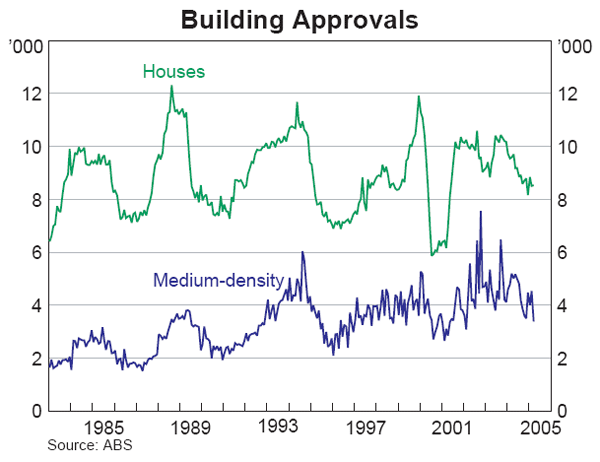
Financing and prices
Demand for housing finance has increased over recent months. The value of housing loan approvals increased, from an average of around $12½ billion per month over the first three quarters of 2004 to $14.2 billion in February (Graph 28). Owner-occupier loan approvals have been rising consistently for much of the past year and are now above their late 2003 peak. Loan approvals to investors have also risen in recent months, but remain 23 per cent below their peak. Over the six months to March 2005, housing credit grew at an annualised rate of 12.9 per cent, with the owner-occupier and investor components now growing at a broadly similar pace.
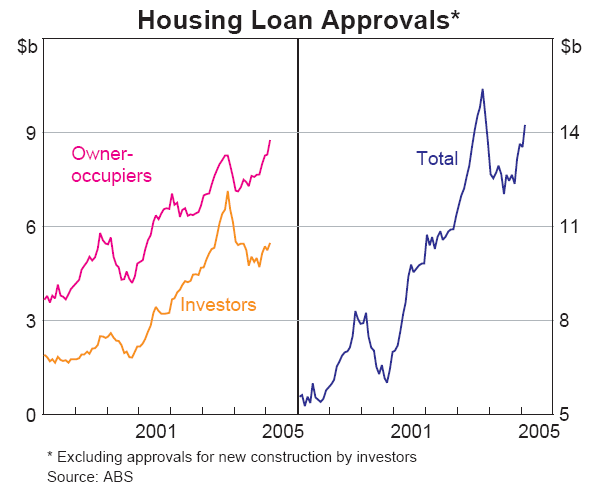
Nationwide house prices appear to have been fairly stable since early 2004. A variety of data are now available for the March quarter, which point to broadly unchanged median house prices, following a slight rise in the December quarter (Table 8 and Graph 29). This assessment is based on the usual wide range of individual estimates, with some allowance made for the seasonal compositional effects that generally boost measured median prices in the December quarter and weigh on the March quarter reading. Preliminary APM contract-dated data, which are sourced from state land titles offices, show a fall in nationwide house prices in the March quarter. These early estimates, however, tend to be progressively revised up as more transactions are settled and processed, and the extent of these revisions in the past suggests a relatively flat final result. Similarly, preliminary data from Residex, which are also sourced from land titles offices but based on repeat sales of individual properties, show that house prices were relatively flat in Sydney, Melbourne and Brisbane in the March quarter. Data from the CBA, which are based on its lending to owner-occupiers, also show broadly unchanged nationwide house prices in the March quarter, after a rise in the December quarter. House prices in Sydney remain lower than they were a year ago, while results are somewhat mixed for Melbourne and Canberra. In contrast, prices rose over the year to the March quarter in Adelaide, Brisbane, Perth and Hobart, albeit at a slower rate than in the previous few years.
| APM(a) | CBA | Residex | ||||||
|---|---|---|---|---|---|---|---|---|
| Mar qtr 2005 |
Year to Mar qtr 2005 |
Mar qtr 2005 |
Year to Mar qtr 2005 |
Mar qtr 2005 |
Year to Mar qtr 2005 |
|||
| Sydney | −6.7 | −8.8 | 0.4 | −12.9 | −0.1 | −2.8 | ||
| Melbourne | 2.5 | 3.8 | −3.2 | −5.8 | 0.5 | −0.6 | ||
| Brisbane | 0.7 | 3.3 | 0.1 | 1.4 | −0.3 | 3.3 | ||
| Adelaide | 2.6 | 10.5 | −4.9 | 3.6 | ||||
| Perth | 5.3 | 14.2 | 8.2 | 12.1 | ||||
| Canberra | 1.5 | 0.1 | −7.0 | −2.4 | ||||
| Australia | −1.3 | −0.3 | −0.4 | −4.4 | ||||
|
(a) Adjusted by the RBA for the average revision in the previous two years Sources: APM; CBA; RBA; Residex |
||||||||
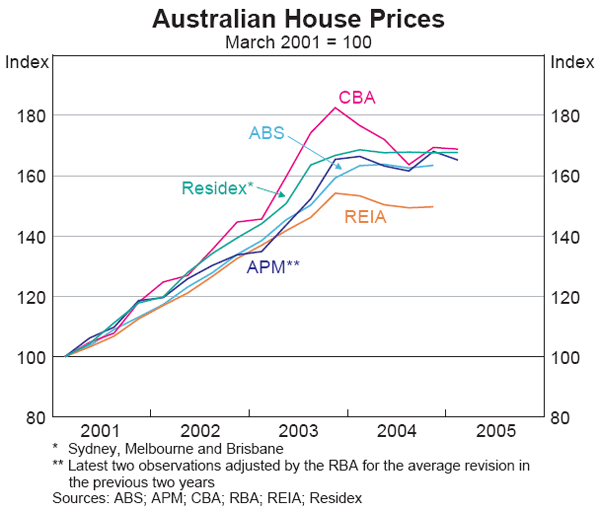
Business sector
Conditions in the business sector generally remain favourable, although business surveys report some easing in conditions since around the start of the year (Graph 30). The March quarter NAB survey and the ACCI Survey of Investor Confidence, covering the non-farm sector, and the Sensis Business Index survey of small and medium businesses, all reported a moderation in conditions and expectations, but the survey responses generally remain at or above their long-run averages. NAB survey respondents also reported that capacity utilisation reached record levels, most notably in construction and in mining where conditions are particularly strong (Graph 31). Capacity constraints on production growth continue to be reported, with firms highlighting shortages of materials, equipment and transport and distribution services. While such reports are widespread, they are most prevalent in the non-residential construction and resource sectors, where they are reportedly resulting in the deferral of some projects.

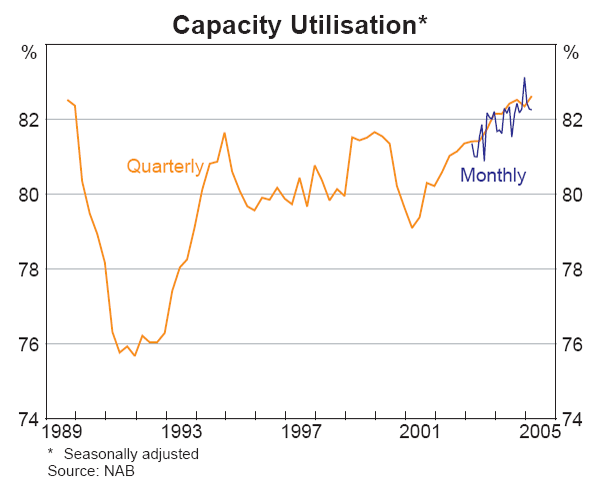
Conditions are not as strong in the manufacturing sector as in the economy overall. The ACCI-Westpac survey of manufacturers reported some softening in business conditions in the March quarter, with the composite index of activity and the measure of capacity utilisation both falling from very high levels, to be closer to their long-run averages. Business confidence declined to below-average levels. Indicators of activity from the AIG's Performance of Manufacturing Index and quarterly survey suggest conditions in manufacturing in the March quarter were at or below their longer-run averages.
Corporate profitability remains strong, although the growth in profits, as measured by private non-financial gross operating surplus (GOS), has eased recently after a period of strong growth (Graph 32). In the December quarter, GOS increased by 0.8 per cent and was broadly flat over the second half of 2004. This moderation in profits growth is somewhat at odds with the more buoyant picture suggested by reported earnings for listed companies, though this may partly reflect differences in definitions and coverage (see the Box ‘December Half 2004 Profit Results’ following the chapter on ‘Domestic Financial Markets’). But on any measure, profitability remains high and is likely to have contributed to the continued expansion of business investment. Businesses have also had ample access to external funds. Over the year to March 2005, business credit grew by around 11½ per cent and outstanding non-intermediated debt increased by around 18 per cent. Similarly, net equity raisings have strengthened over the past few months and in the March quarter 2005 were above their average of the past five years.
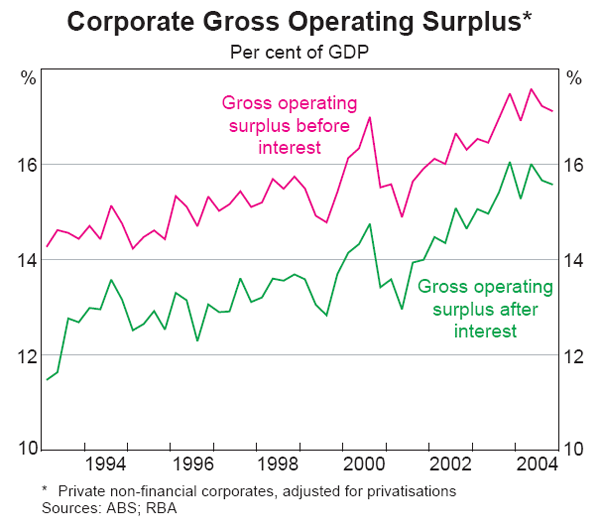
Consistent with the high levels of capacity utilisation and profitability reported by firms, the upswing in business investment seen in recent years continued through 2004, with growth of almost 10 per cent over the year. Capital spending grew rapidly in the December quarter with strong growth recorded across all components. Machinery & equipment investment continued to expand rapidly in the quarter; spending in this area has now increased by around 5 per cent in each of the past three quarters, in line with sustained growth in capital imports. Non-residential construction also recorded a large rise, driven by a sharp rebound in building activity together with strong growth in the engineering component.
The outlook for business investment remains positive, with high capacity utilisation rates and a generally favourable outlook for the domestic economy providing considerable incentive to invest. Still-strong profitability and a favourable financing climate also ensure that firms have ample access to funds for expanding capacity. The latest capital expenditure (Capex) survey points to continued growth in business investment in real terms, though at a more moderate pace than that seen during 2004. For machinery & equipment, the surveyed investment intentions imply reasonably solid growth in 2005/06, largely reflecting a pick-up in spending in the transport & storage sector. The Rabobank survey, conducted in the March quarter, suggests that investment intentions for farm equipment (which are not covered in the Capex survey) remain close to pre-drought levels.
Forward-looking indicators of non-residential construction suggest a continuation of the upswing in activity experienced over the past three years, albeit at a more moderate pace. Growth is expected to be supported by the large amount of engineering work due to get underway in 2004/05, including some large resource-related projects (Graph 33). However, the building activity component is facing a softer outlook as the amount of building work approved recently has fallen well short of the current level of construction.
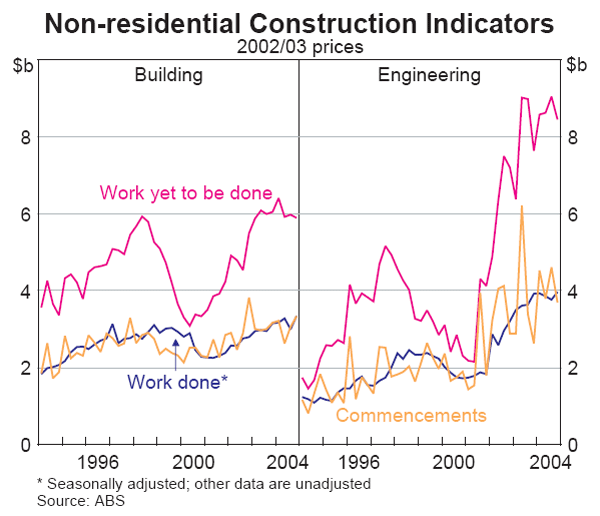
Labour market
After firming considerably over the December quarter of 2004, labour market conditions have remained buoyant in the new year. Three strong monthly increases in the March quarter brought year-ended employment growth to 3.4 per cent in March, up from 2.7 per cent in December (Graph 34). Employment growth continues to be concentrated in the full-time component, although in the last six months the contribution from part-time jobs has increased. The surprising combination of strength in employment growth and weakness in output growth in the second half of 2004 implies that labour productivity, as measured by output per hour worked, fell by 0.4 per cent over 2004. While some slowing in labour productivity growth might be expected as firms find it more difficult to find suitable labour, the recorded slowing seems unusually pronounced. The acceleration in employment has been matched by an increase in the participation rate to 64½ per cent in March, after a period where it had been fairly constant at around 63½ per cent. The unemployment rate remained stable at 5.1 per cent between December 2004 and March 2005, the lowest rate seen since late 1976. While all states recorded falling unemployment rates over the year and an increase in the pace of year-ended employment growth in the March quarter, labour market performance continues to diverge. Growth in employment has been especially strong in the resource-intensive states of Queensland and Western Australia, and well below the current national average pace in New South Wales (for more detail, see ‘Box B: Divergences in Regional Performance’).
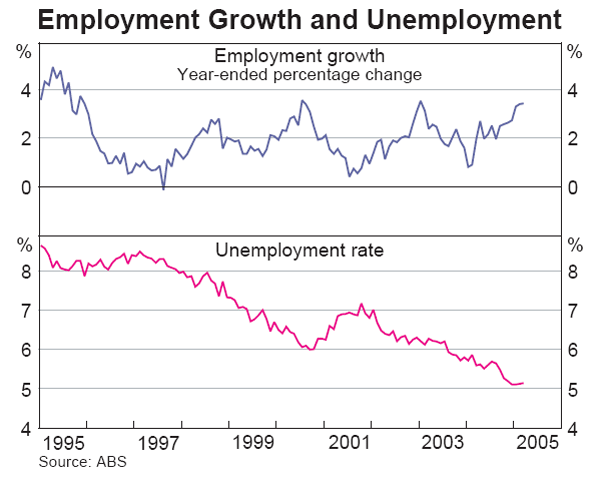
Employment gains were seen in most industries over the year to the March quarter. The mining, retail, and construction industries all experienced growth in employment of more than 5 per cent. Employment in property & business services increased again in the March quarter and returned to positive growth over the year. In contrast, employment growth was below average for manufacturing and slowed in industries, such as education, that supply household services.
Although it would not be surprising to see some weakness in measured employment in coming months, given the extraordinary strength seen recently, forward-looking indicators of labour demand suggest continued underlying momentum in employment in the near term (Graph 35). The ACCI-Westpac and NAB survey measures of hiring intentions eased in the March quarter from recent peaks, but their levels are still well above long-run averages. Similarly, print- and internet-based measures of vacancies indicate a high level of demand, although the interpretation of quarterly movements has been affected by unusual holiday-related seasonality. The ABS measure of job vacancies increased strongly in the March quarter, to be more than 40 per cent higher than a year earlier. Liaison indicates that labour shortages are most pronounced among skilled workers in the non-residential construction and resources sectors, and in parts of the business services sector. However, labour shortages are becoming increasingly broad-based across industries and skill levels. Consistent with this, business surveys indicate that difficulty finding suitable labour has become a key factor constraining output.
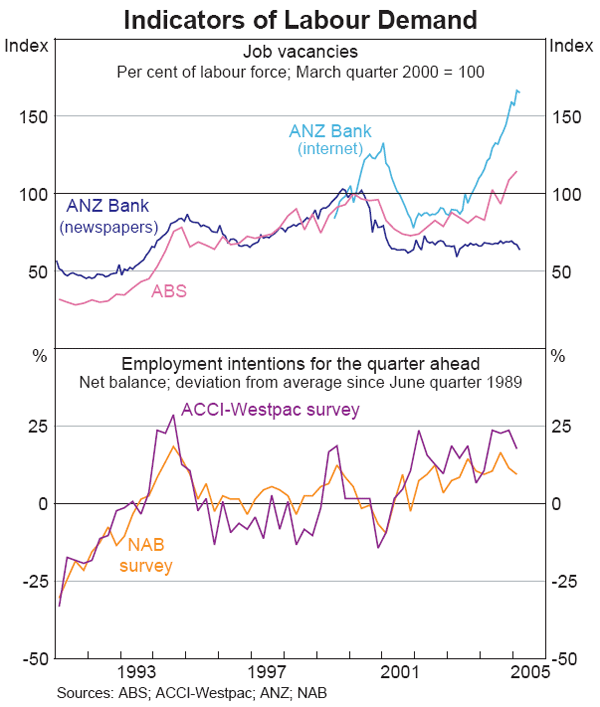
Box B: Divergences in Regional Performance
National economic outcomes typically mask some regional variation, but there appears to be a greater than usual divergence in regional performance at present. This disparity is most evident in the labour market. Employment has expanded rapidly over the past year in most states, especially Queensland and Western Australia, which both recorded growth rates above 5 per cent. In contrast, employment in NSW has been increasing more slowly than elsewhere since early 2003 and is presently growing at around trend rates. This is reasonably healthy by historical standards, but is less than half the pace currently seen in the rest of the country (Graph B1). While unemployment rates have fallen in all states over the year, the extent of the falls has also varied widely (Table B1). The unemployment rate has fallen less in NSW than in the smaller states, and it is now above the national average for the first time since the early 1990s, whereas Queensland's unemployment rate has fallen almost 2 percentage points to be the lowest across all states.
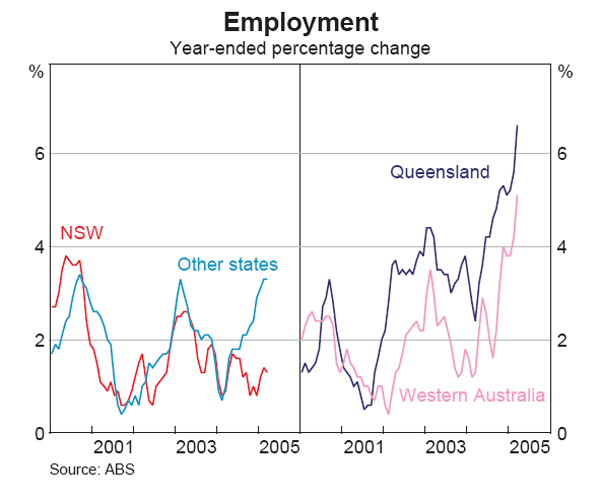
| Employment growth | Unemployment rate | ||||
|---|---|---|---|---|---|
| Quarterly | Year-ended | Level | Year-ended change(a) | ||
| NSW | 0.9 | 1.3 | 5.3 | −0.1 | |
| Victoria | 0.9 | 3.5 | 5.5 | −0.2 | |
| Queensland | 1.7 | 6.6 | 4.5 | −1.8 | |
| WA | 1.8 | 5.1 | 4.8 | −0.8 | |
| SA | 0.9 | 2.6 | 5.4 | −1.0 | |
| Tasmania | 1.5 | 3.0 | 5.7 | −1.2 | |
| Australia | 1.1 | 3.4 | 5.1 | −0.6 | |
|
(a) Percentage points Source: ABS |
|||||
The slower employment growth in NSW than elsewhere has been associated with a marked easing in the state's population growth. Population growth in NSW decelerated sharply in 2001 and 2002, and has since lagged significantly behind that in the rest of Australia (Graph B2). While net overseas migration to NSW has fallen over this period, increased outflows of residents to other states have accounted for around two-thirds of the decline in population growth. Changes in the flows of interstate migration are generally associated with relative employment opportunities and housing affordability; consistent with this, the sharpest fall in population growth in NSW coincided with a pronounced decline in the state's relative housing affordability and employment growth.
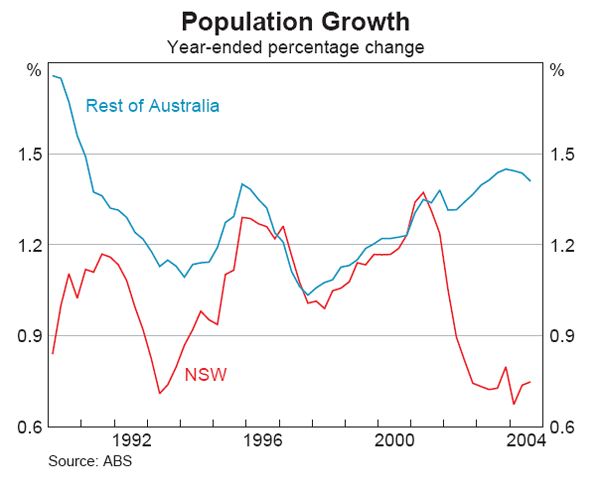
The divergence in employment outcomes between the states accords with differences in indicators of economic growth. Final demand – the most comprehensive measure of state activity available on a quarterly basis – has been growing rapidly in Queensland and Western Australia, supported by exceptional strength in dwelling investment and consumption spending. In contrast, final demand in NSW has been running at rates well below the national average for several years (Graph B3), largely reflecting slower growth in consumption. More recently, this has been exacerbated by a downturn in housing construction, since the housing cycle in NSW is somewhat ahead of that in other states. Using a broader measure of output that includes international trade in goods,[1] it appears that net trade is also weighing more heavily on growth in NSW than in other states, particularly those most exposed to the current resources boom. This is highlighted by recent trends in the value of state exports, which show a solid expansion in Western Australia and more recently in Queensland, buoyed by strong demand for resources and high commodity prices. In contrast, exports in NSW and other states remain below the levels seen in 2001, with NSW particularly affected by the severity and persistence of drought.
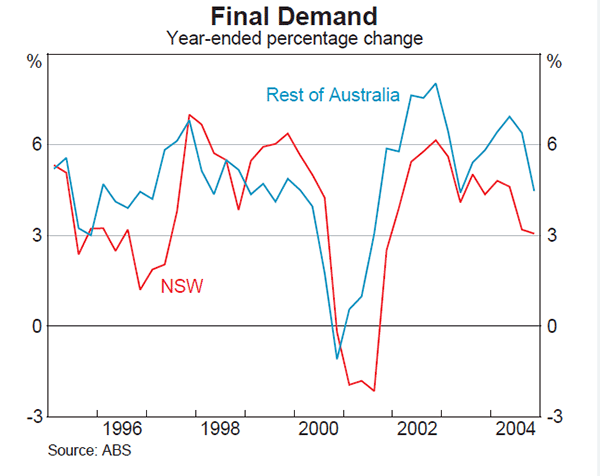
Balance of Payments
In recent years Australia's balance of payments has been characterised by a lacklustre expansion in export volumes, rapid growth in import volumes, and a sharp increase in the terms of trade. The latter stages of 2004 generally saw a continuation of these trends. Encouragingly, though, there are early signs of a firmer recovery in exports. Strong growth in the resources area underpinned a modest lift in overall export volumes in the December quarter 2004, and more recent monthly data point to further growth in the new year. On the import side, continued strength in domestic demand, the high exchange rate and, more recently, tariff reductions on some goods have resulted in renewed strength in import volumes. While growth in import volumes continued to outpace that of exports in the December quarter, the effect on the trade balance was again cushioned by a rise in the terms of trade, leaving the trade deficit broadly unchanged at 3.2 per cent of GDP (Graph 36). Given the large increases in contract prices for iron ore and coal that have recently been negotiated, a further significant rise in the terms of trade is expected around mid year, along with some narrowing in the trade deficit.
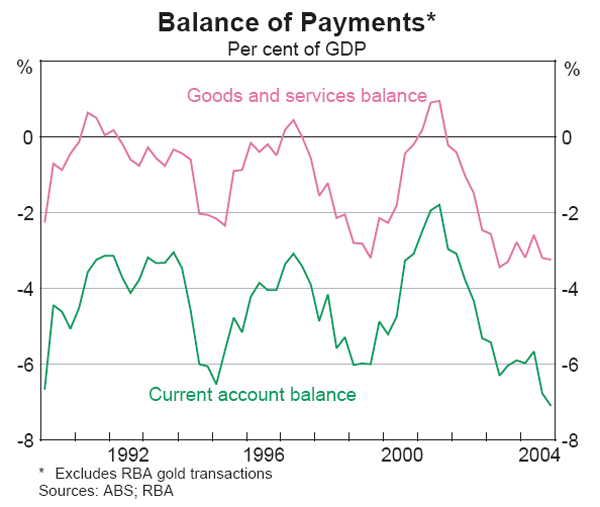
Somewhat unusually, movements in the current account deficit (CAD) have recently been dominated by developments in the net income deficit (NID), with its sharp increase in the second half of 2004 pushing the CAD to 7.1 per cent of GDP in the December quarter, the largest since quarterly ABS data began in 1959. In the year to the December quarter 2004, the net income deficit increased by about one-third, to $8.2 billion or 3.8 per cent of GDP. Interest payments to foreign holders of Australian debt rose broadly in line with growth in the stock of debt, while payments on foreign holdings of Australian equity rose sharply (see Box C for a more detailed discussion of Australia's net income deficit).
Exports
Export earnings increased by almost 12 per cent over 2004, mainly the result of sharp increases in resource export prices. Growth in export volumes over the year was subdued, with a recovery in rural exports and an increase in manufactured exports largely offset by weakness in other categories. Export volumes posted a modest rise in the December quarter 2004, driven by a nascent recovery in resource exports and solid growth in manufactured exports (Graph 37). More recently, monthly trade data for January and February indicate that both the value and volume of exports are likely to have risen further in the March quarter.
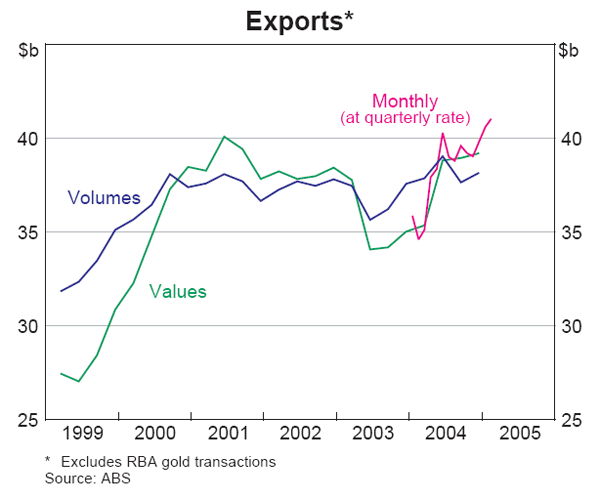
Rural export earnings increased strongly in late 2003 and early 2004 from the low levels associated with the drought. In addition, bans on meat imports from the US and Canada have led to strong international demand for Australian beef. Since mid 2004, however, rural export earnings have fallen, mostly due to a decline in cereals exports, following the smaller winter crop in 2004/05, and weaker exports of wool. Looking forward, meat exports are expected to remain at a high level in the near term, though they are likely to ease subsequently as the US re-enters the Japanese beef market, following the conditional lifting of a BSE-related ban. The Australian Bureau of Agricultural and Resource Economics (ABARE) expects summer crop production to grow by 13 per cent in 2004/05, which should support cereals exports in coming quarters. Further ahead, and assuming average seasonal conditions, ABARE is forecasting the winter crop to increase by 12 per cent in 2005/06. However, there may be some downside risk to this outlook, as the Bureau of Meteorology has indicated an above-average probability of El Niño conditions emerging later this year.
The value of resource exports rose by 25 per cent over 2004, propelled by sharply higher commodity prices. In the December quarter, the volume of resource exports rose by 6½ per cent, after having declined over the earlier part of the year. The increase in the quarter was broadly based across components, with particularly large rises recorded in exports of ‘other mineral fuels’ and non-monetary gold, as production commenced from the 4th LNG train at the North-West Shelf and at a range of new gold mines, including the Telfer redevelopment. As outlined in the previous Statement, the outlook for the resources sector is quite favourable: external demand remains buoyant, a large number of new projects are due to commence production, and there is likely to be some easing of transport infrastructure constraints.
The value of manufactured exports increased solidly over 2004, owing to growth in both volumes and prices. In the December quarter, the volume of manufactured exports rose by 3½ per cent. Over the past few years, manufactured export volumes have performed more strongly than other categories, though growth has been well short of the rapid pace seen in the 1990s. Liaison reports suggest that the high level of the exchange rate and the flow of low-cost goods from developing countries onto the world market are hampering the competitiveness of Australian producers. Most other industrial countries have also experienced only modest growth in manufactured exports so far this decade, all of which may suggest that a return to the rapid growth rates seen during the 1990s is unlikely.
The volume of services exports fell steadily over the course of 2004, and drove a decline in services export earnings. The weakness in volumes was fairly broad-based, with contractions evident in exports of travel and freight services, while exports of other transportation services (including air travel) were broadly flat. More recently, monthly trade data for January and February suggest that services export volumes are likely to have risen in the March quarter. The outlook for tourism-related services appears positive, with short-term visitor arrivals showing a firm upward trend and industry contacts reporting solid international demand.
Imports
Import volumes appear to have considerable momentum, growing by 3¼ per cent in the December quarter and by more than 13 per cent over 2004. Underpinning this expansion was continued solid growth in domestic demand, coupled with the appreciation of the Australian dollar over the past several years. All major import categories rose solidly in the December quarter and over the year, with particularly strong growth in the goods categories over the past year (Graph 38).
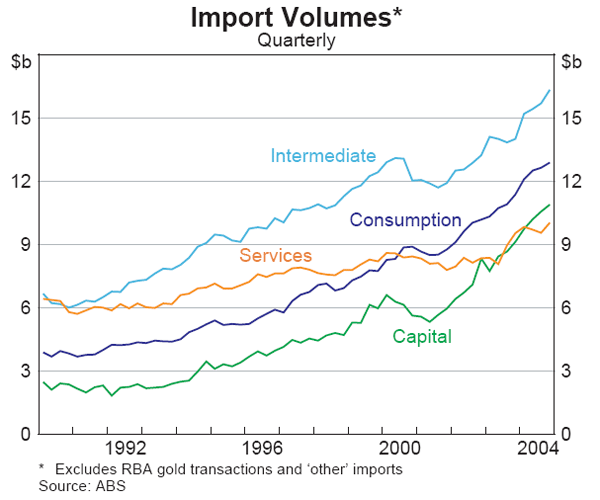
More recent data suggest that growth in import volumes remained firm in the early stages of 2005. In the March quarter, the value of imports appears likely to have risen by around 2½ per cent, with strong growth in import volumes and lower prices owing to a further appreciation of the Australian dollar. Imports of consumption goods in the quarter received a boost from the reduction in some tariffs on 1 January; tariffs on imports of passenger motor vehicles and parts fell from 15 per cent to 10 per cent, while the average tariff on textiles, clothing & footwear fell from 21 percent to 14½ per cent.
Commodity prices and the terms of trade
Preliminary estimates indicate that the RBA Index of Commodity Prices (ICP) rose by 8.7 per cent in SDR terms over the three months to April, to be 12.5 per cent higher over the year (Table 9). Much of the recent strength has come from a steep rise estimated for ‘other resource’ prices, as sharply higher contract prices for iron ore and coal began to take effect from 1 April, and to a lesser extent, from rising base metals prices. In Australian dollar terms, commodity prices rose by 6.6 per cent over the three months to April, and they were up by more than 12 per cent over the year.
| Three months to April 2005 |
Year to April 2005 |
|
|---|---|---|
| RBA Index | 8.7 | 12.5 |
| Rural | −1.7 | −7.9 |
| – Wheat | −4.9 | −17.2 |
| – Beef & veal | −5.0 | 3.1 |
| – Wool | −0.3 | −5.5 |
| Base metals | 6.7 | 13.2 |
| – Aluminium | 3.8 | 5.8 |
| – Copper | 8.0 | 12.0 |
| – Nickel | 11.9 | 21.8 |
| Other resources | 14.5 | 24.0 |
| – Coking coal(a) | 36.5 | 59.3 |
| – Steaming coal(a) | 5.0 | 32.9 |
| – Iron ore(a) | 24.9 | 15.3 |
| – Gold | 2.3 | 2.8 |
| Memo item: | ||
| Oil in US$(b) | 12.9 | 44.2 |
|
(a) Estimates from February to April inclusive. Sources: ABS; AWB; AWEX; Bloomberg; Meat and Livestock Australia; RBA |
||
Base metals prices increased by around 7 per cent over the three months to April, although there was some retracement during April. All metals prices have posted significant overall gains, supported by strong speculative and physical demand and associated stock drawdowns. The rise in nickel prices and fall in stocks have been especially sharp, owing to resurgent demand from China.
Rural prices declined overall as falls in the prices of wheat and beef & veal offset a pick-up in cotton prices. The most recent fall in wheat prices was driven by the favourable outlook for the US crop. Cotton prices have strengthened over recent months amid expectations of lower global plantings and higher Chinese import demand.
Sharply higher contract prices for coal and iron ore in 2005/06 took effect from the beginning of April and are expected to boost the Bank's Index of Commodity Prices by around 25 per cent, once they are fully included in published transaction prices. Based on past experience, the effects should largely flow through over the next few months. As a result of the strong global demand for steel, coking coal producers negotiated an increase of around 120 per cent in contract prices, with iron ore contract prices generally rising by more than 70 per cent (Graph 39). Steaming coal producers appear to have achieved more modest price increases of close to 20 per cent, though this follows rises of 68 per cent negotiated in 2004/05.
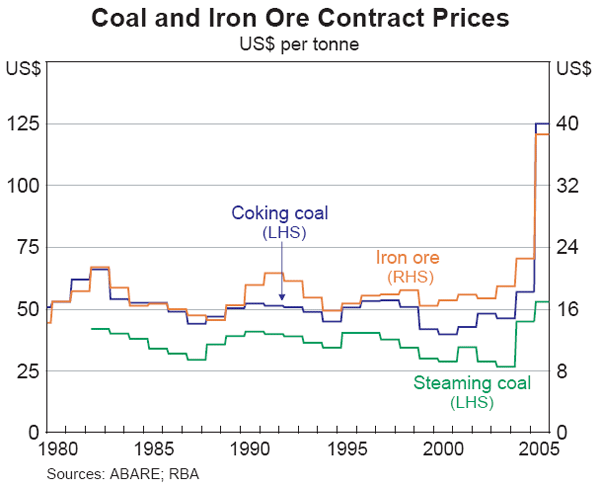
The terms of trade rose by 1.6 per cent in the December quarter, to be 10 per cent higher over the year, and at the highest level seen in more than 30 years (Graph 40). The increase in the quarter reflected a further small rise in world commodity prices and other goods export prices, coupled with gains in the services terms of trade. Trade prices data suggest an increase of more than 2 per cent in the March quarter, and further significant rises in the terms of trade are expected around mid 2005 as the new contract prices for coal and iron ore take effect.
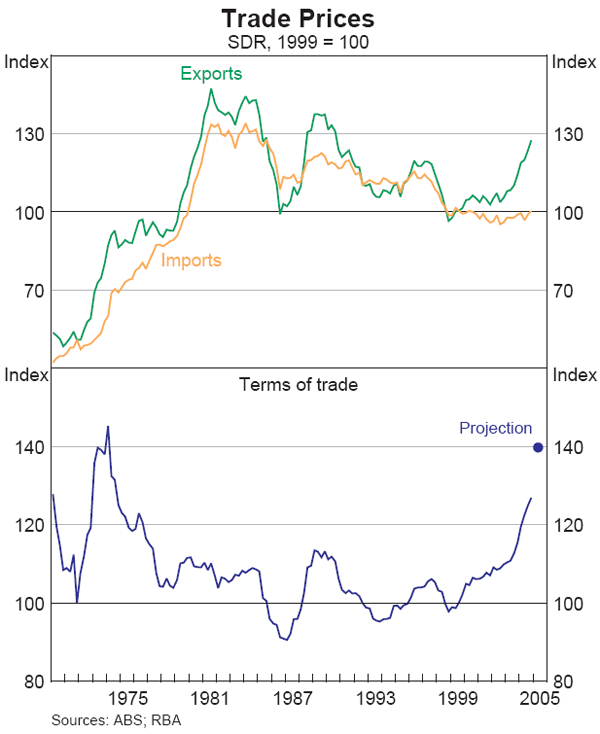
Despite an increase of ½ million barrels per day in OPEC's production ceiling in March, the West Texas Intermediate crude oil price has increased over the past three months. Forecasts for global demand in 2005 have generally been revised up over the past few months, although a more recent International Energy Agency (IEA) report showed a slight downward revision. This comes at a time when supply is constrained by limited spare capacity, and speculative demand has been boosted by research reports suggesting that the price of oil could move significantly higher.
Box C: Australia's Net Income Deficit
During the second half of 2004, Australia's current account deficit widened by almost 1½ per cent of GDP to over 7 per cent of GDP, the highest level since the early 1950s. In contrast to other movements in the current account deficit during recent years, which were mainly the result of fluctuations in Australia's trade balance, the most recent increase largely reflected rising payments on Australia's stock of net foreign liabilities – the net income deficit (Graph C1). At 3¾ per cent of GDP, the December quarter 2004 net income deficit (NID) was the largest recorded since September 1996.
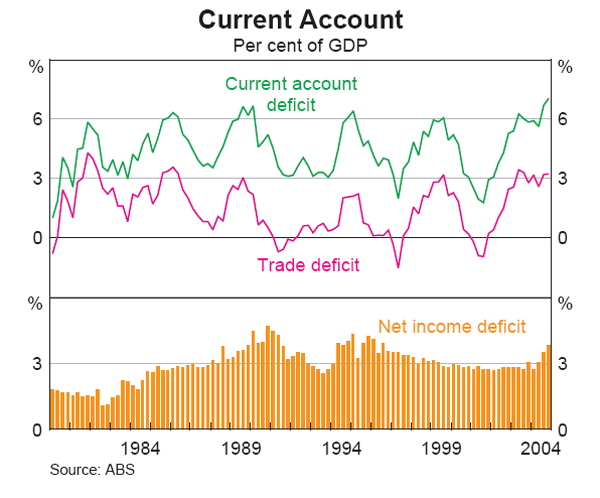
The increase in the NID in the second half of 2004 was driven by an increase in income accruing to foreigners on their debt and equity investments in Australia, while returns received on Australian holdings of foreign assets remained broadly unchanged (Graph C2). There was a particularly marked increase in the income attributed to foreign owners of direct equity stakes in Australian firms, which was in contrast to trends in economy-wide measures of profitability, such as gross operating surplus. A substantial fraction of these earnings are not paid out, but retained by the Australian company, and are offset in the balance of payments by an equivalent notional capital inflow.[1] The latest increase has been almost entirely driven by this component.
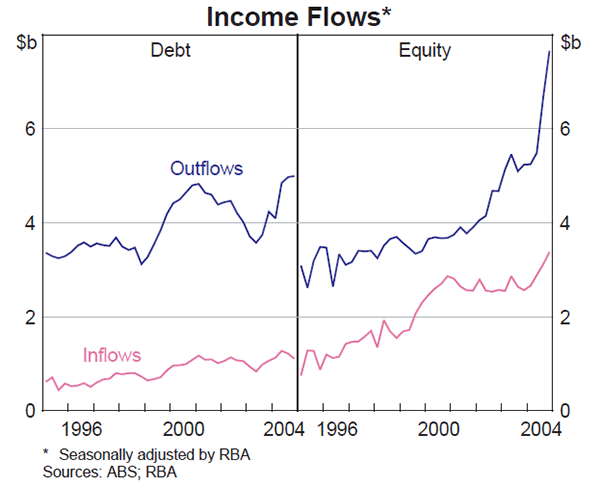
The large contribution of equity earnings to the recent increase in the NID stands in contrast to earlier episodes of a rising NID, which were mainly driven by developments on the debt side. Ongoing current account deficits have resulted in a steadily rising net foreign liabilities position, from around 25 per cent of GDP in the early 1980s to around 65 per cent of GDP by the end of 2004, over 75 per cent of which are net debt liabilities (Graph C3). The higher level of liabilities that must be serviced would normally have significantly increased the NID over this period, but this effect was substantially offset by trend declines in global interest rates over the past two decades.
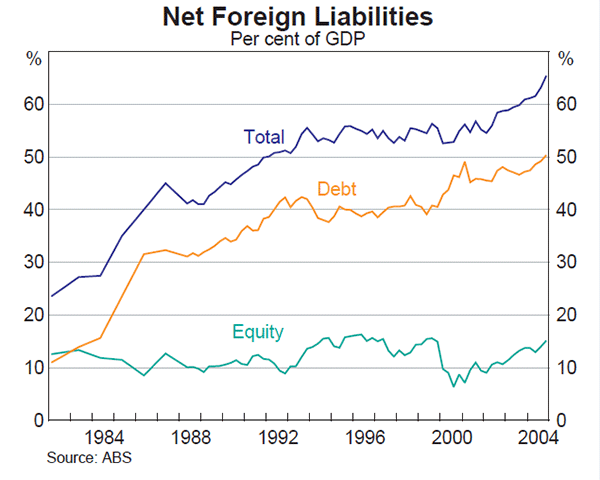
Looking forward, it is likely that the decline in global interest rates has now run its course, eliminating this source of downward pressure on the NID. As a result, the cost of servicing Australia's net foreign debt liabilities may rise from its current relatively low base, as global interest rates rise and the stock of foreign debt liabilities increases in line with projected ongoing current account deficits.
Domestic Financial Markets
Interest rates and equity prices
Money and bond yields
The increase in the cash rate target from 5¼ to 5½ per cent announced in early March came as no surprise to financial markets. At the time of the increase, the market was also factoring in a further tightening in monetary policy over the next six months. Market expectations of a tightening had been building since the previous Statement and were reflected in short-term market yields, which rose by around 30 basis points between early February and early March (Graph 41).
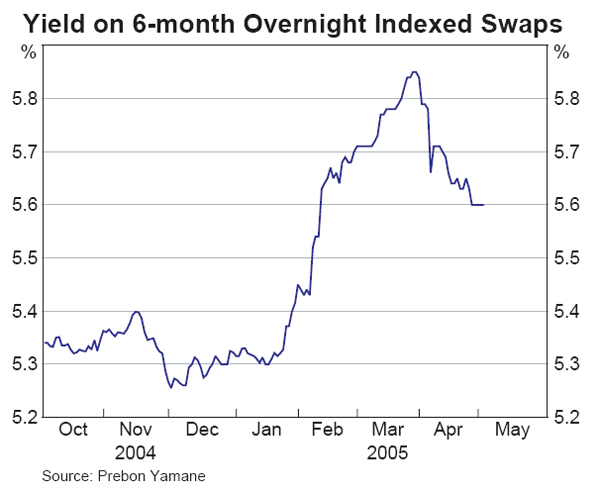
These yields rose further in the weeks immediately following the rise in the cash rate target as markets continued to revise upward their expectations for a further tightening. Market behaviour at that time seemed based on the assumption that the pattern of successive monthly interest rate increases in 2002 and 2003 could be repeated. The rise in yields began to unwind in late March, however, in response to the fall in global equity prices and growing concern about the impact of higher oil prices on global economic activity. By April, the chance of a monetary tightening was seen as being only about 50:50 and by May the market had come to the view that there was little chance of a further rate rise.
Long-term yields have mirrored the pattern in short-term yields since the last Statement, rising in February and March then falling in April, largely in response to developments in overseas markets (Graph 42). In net terms, though, long-term rates are little changed over this period. Yields on 10-year government bonds, at 5.3 per cent, are now around the same as at the time of the previous Statement despite having been as high as 5.8 per cent in late March. Yields on inflation-linked bonds, at 2.7 per cent, are also largely unchanged in net terms since early February. In contrast to yields on nominal bonds, yields on inflation-linked bonds have for the past six months remained close to their lowest recorded levels.
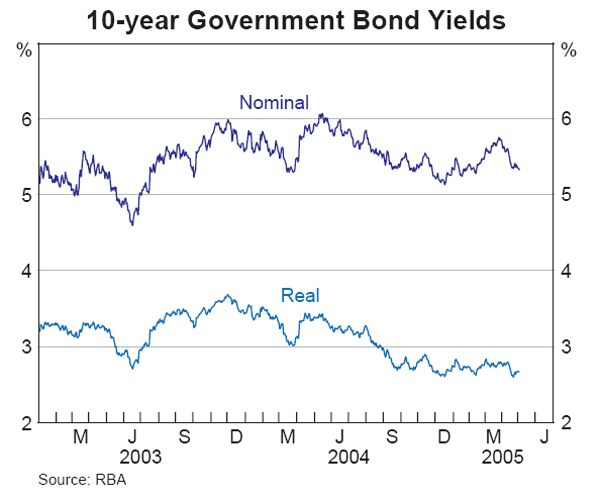
The small net change in local bond yields since February is consistent with developments in the US over the same period. As a result, the current spread between Australian and US 10-year bond yields, of around 115 basis points, is much the same as at the time of the last Statement.
The shape of the yield curve has changed markedly since early February, with the curve now inverted. Since early April, the yield on 10-year bonds has moved from being around 15 basis points above the cash rate to being around 20 basis points below. This is discussed further in the chapter on ‘Financial Conditions’.
Spreads between corporate bond yields and swap rates, which are a measure of the market's credit risk perceptions, have fallen slightly since the previous Statement (Graph 43). This is in contrast to US and European markets, where corporate bond spreads to swaps have risen over the period. The premia on credit default swaps, an alternative measure of credit risk perceptions, have risen. Both measures, however, remain low by historical standards, suggesting that markets continue to see the outlook for the domestic corporate sector as fairly favourable.
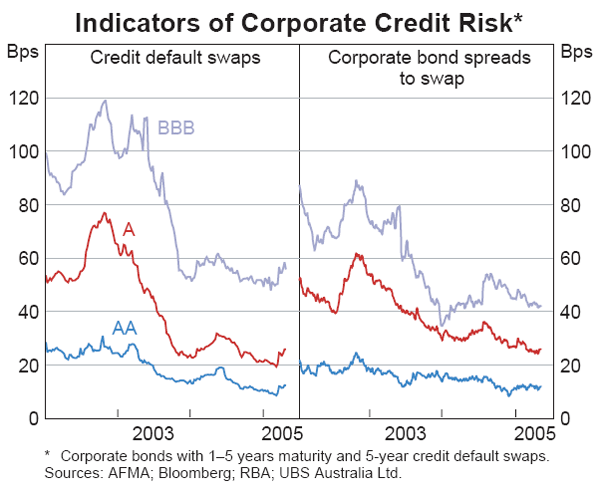
Intermediaries' interest rates
Following the 25 basis point increase in the cash rate in early March, most lenders have increased the indicator rates on their variable-rate housing and personal loans by a similar amount (Graph 44, Table 10). However, the average increase in mortgage managers' basic housing rate has been less, at 20 basis points. All of the major banks have increased their standard credit card interest rates by at least 25 basis points, with a couple announcing slightly higher increases.
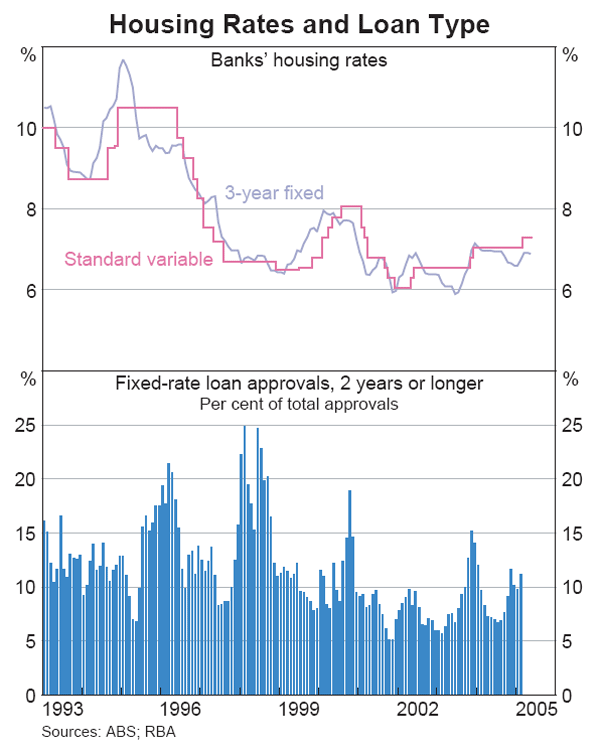
| Current level (3 May) |
Change since end January |
|
|---|---|---|
| Variable rates – household | ||
| Housing: | ||
| – Major banks' standard variable | 7.30 | +0.25 |
| – Major banks' basic variable | 6.75 | +0.25 |
| – Mortgage managers' standard variable | 6.95 | +0.25 |
| – Mortgage managers' basic variable | 6.45 | +0.20 |
| Other household: | ||
| – Residential security | 7.45 | +0.25 |
| – Credit cards | 16.75 | +0.30 |
| Variable rates – small business | ||
| Residential security: | ||
| – Overdraft | 8.20 | +0.25 |
| – Term loan | 7.50 | +0.25 |
| Other security: | ||
| – Overdraft | 9.10 | +0.25 |
| – Term loan | 8.10 | +0.25 |
| Variable rates – large business | ||
| – Overdraft | 9.10 | +0.25 |
| Fixed rates (3 years) | ||
| – Housing | 6.90 | +0.30 |
| – Small business | 7.40 | +0.05 |
| – Swap rate | 5.75 | – |
|
Source: RBA |
||
While lenders have increased their housing indicator rates, the trend of the past couple of years has been partly to offset rises in indicator rates by offering bigger discounts or discounted loans to a wider range of borrowers. A measure of this discounting is only available with a significant lag, but the latest figures suggest that around 80 per cent of borrowers taking out variable-rate housing loans pay less than the indicator rate for these loans. The weighted-average rate paid by new borrowers was almost 50 basis points below the standard variable indicator rate in mid 2004, with this average discount having doubled over the previous two years.
Interest rates on fixed-rate housing loans have increased by around 30 basis points since the previous Statement. This largely reflects the earlier rise in the cost of funding fixed-rate loans, evident in higher swap rates. The major banks' average 3-year fixed housing rate is currently 6.90 per cent, 40 basis points below their standard variable indicator rate, but closer to the variable rate actually charged to new borrowers given the prevalence of discounting. Demand for fixed-rate housing loans was fairly strong in late 2004 and early 2005, ahead of the monetary policy tightening announced in early March. In February, the latest month for which data are available, around 11 per cent of new owner-occupier loans were taken out at fixed rates, broadly in line with the average share over the preceding four months, but above the 7 per cent share that existed in the middle of 2004.
Interest rates on variable-rate business loans have risen by 25 basis points following the monetary policy tightening (Table 10). Rates on fixed-rate loans for small businesses have moved up a little since the previous Statement, rising by around 5 basis points in net terms.
Equity prices
The Australian share market continued to rise rapidly in the early part of 2005. By 21 March, its recent peak, the market was up 25 per cent from a year earlier and almost 60 per cent from its low point in early 2003. More recently, however, the market has fallen by around 7 per cent, broadly in line with international equity markets, which in turn have been particularly sensitive to economic news from the US. The net effect of recent developments is that Australian share prices have fallen by 3 per cent since the previous Statement, similar to the net falls in the S&P 500 and MSCI World indices over the same period (Graph 45). Mining and energy companies accounted for a large part of the advance in the ASX 200 in the early part of the year and for much of its subsequent decline (Graph 46).
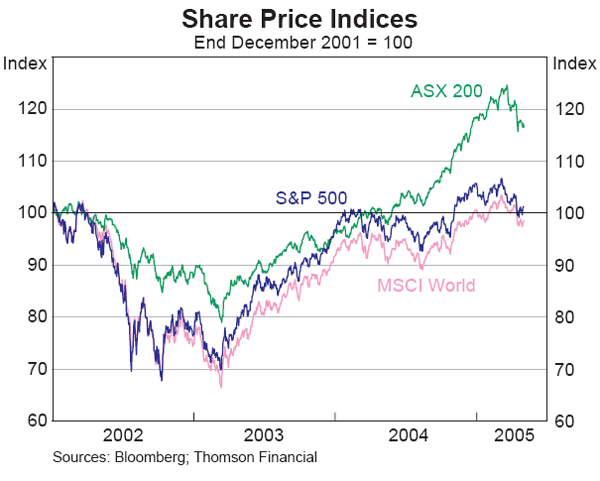
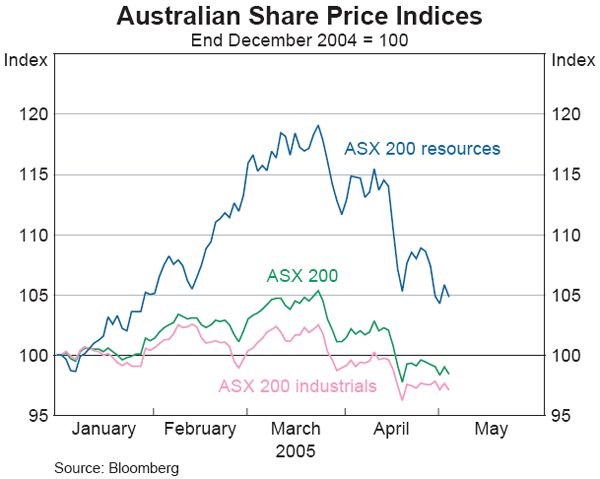
A strong rise in company earnings in the December half year (see Box D), together with the recent fall in share prices, has seen the price-earnings ratio (P/E) fall from 21 to 15, which is around its long-run average (Graph 47). So far, only a portion of this rise in company profits has been passed on to shareholders in the form of higher dividends; in April, the dividend yield was 3.7 per cent compared with 3.3 per cent in January. In recent weeks, a number of companies have issued profit warnings for 2004/05 as a whole. While these warnings have attracted considerable attention, the companies concerned account for around 2 per cent of total market capitalisation.
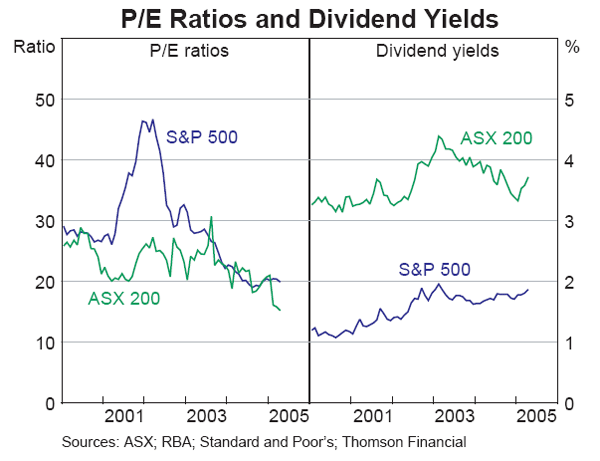
Financing activity
Debt markets
Australian non-government entities issued $40 billion of bonds in the March quarter (Table 11 and Graph 48). This was broadly in line with average quarterly issuance in 2004, but below the very strong issuance seen in the first quarter of last year.
| Sector | 2002 | 2003 | 2004 | 2005 | |
|---|---|---|---|---|---|
| March quarter |
April | ||||
| Bond issues by Australian entities | |||||
| Onshore | |||||
| Financial institutions | 7.4 | 9.8 | 14.0 | 6.1 | 0.8 |
| Non-financial corporates | 7.6 | 4.9 | 8.0 | 1.1 | 0.9 |
| Asset-backed | 19.3 | 21.2 | 25.0 | 8.6 | 3.6 |
| Total | 34.3 | 35.9 | 46.9 | 15.8 | 5.3 |
| Offshore | |||||
| Financial institutions | 31.9 | 49.8 | 63.9 | 14.8 | 4.4 |
| Non-financial corporates | 10.5 | 14.7 | 14.3 | 2.2 | 1.1 |
| Asset-backed | 16.5 | 24.3 | 29.8 | 7.1 | 1.4 |
| Total | 58.9 | 88.9 | 108.0 | 24.1 | 6.9 |
| Total | 96.3 | 124.7 | 154.9 | 39.9 | 12.2 |
| A$ bond issues by non-resident entities | |||||
| Onshore | 3.1 | 7.1 | 21.3 | 6.1 | 0.5 |
| Offshore | 17.3 | 24.4 | 21.5 | 4.8 | 0.4 |
| Total | 20.4 | 31.5 | 42.9 | 10.9 | 0.9 |
|
Source: RBA |
|||||
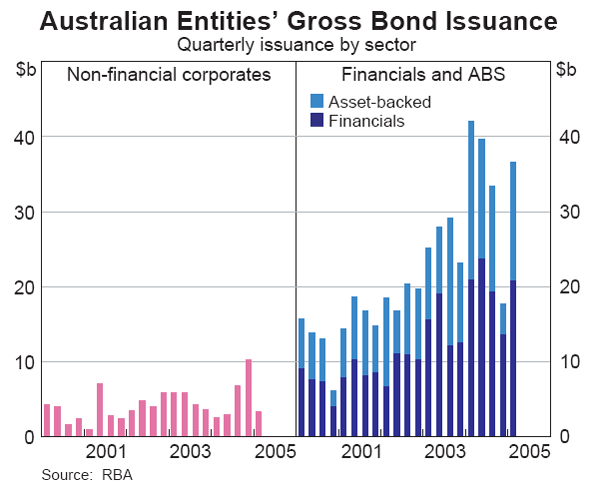
Asset-backed vehicles issued $16 billion of bonds in the quarter, with this amount fairly evenly split between onshore and offshore markets. The value of issuance by asset-backed vehicles was 25 per cent below the value seen in the corresponding period of 2004 but investor demand for mortgage-backed securities remains strong, as evidenced by the fact that primary spreads remain close to their historical lows. Bonds issued by financial institutions totalled $21 billion in the March quarter, much the same as in the corresponding period of 2004. Issuance by non-financial corporates either onshore or offshore totalled a little over $3 billion, following a record $10 billion of issuance in the December quarter of last year.
Over the March quarter, the value of non-government bonds outstanding in Australia increased by $16 billion to $193 billion (Graph 49). This increase was fairly evenly split between asset-backed, non-resident and financial institutions' bonds. The outstanding amount of Commonwealth Government bonds increased slightly to $54 billion, while the state governments' bond outstandings rose more strongly, to $62 billion. The rise in state government bonds partly reflects a switch from offshore issuance and some refinancing of debt that is due to mature shortly.
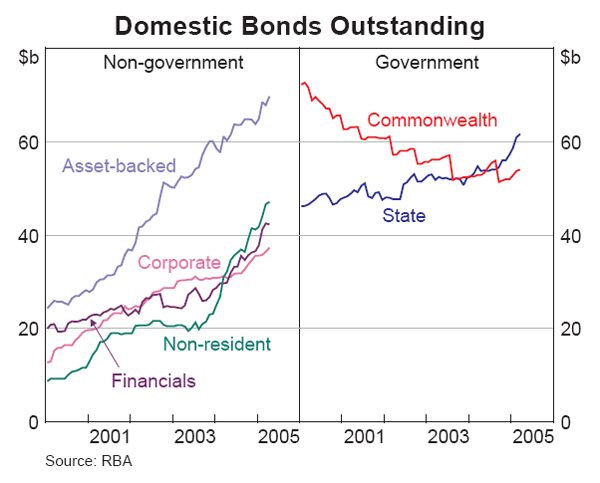
Hybrid raisings
Australian entities' issuance of hybrid securities has remained robust in 2005 to date, with almost $3 billion issued since the previous Statement. Financial institutions accounted for more than half of issuance, with 55 per cent of total hybrid issuance by Australian entities going into offshore markets. The adoption of International Accounting Standards in Australia has continued to guide the types of hybrid securities being issued. Perpetual step-up preference shares (which are classified as equity for tax and accounting purposes) have accounted for the majority of issuance by both financial and non-financial institutions since the previous Statement.
Equity raisings
Net equity raisings totalled $6.4 billion in the March quarter, about 40 per cent higher than the quarterly average since the beginning of 2000 (Graph 50). There were 32 initial public offerings (IPOs) raising a total of $1.1 billion during the quarter, although almost half of the total related to one large investment company. Non-IPO raisings were stronger, at $5.7 billion, with many of the larger raisings being undertaken by property and infrastructure funds for the acquisition of interests in new properties. Non-IPO raisings have been the major means by which equity has been raised in recent years. Non-IPO raisings mainly comprise: placements, in which shares are offered without a prospectus to a limited number of large investors; rights issues, where shares are offered to all shareholders in a fixed ratio to their existing holdings; dividend reinvestment plans, where shareholders' dividends are reinvested in additional shares rather than paid as cash; and employee share plans, including the exercising of executive options (Graph 51).
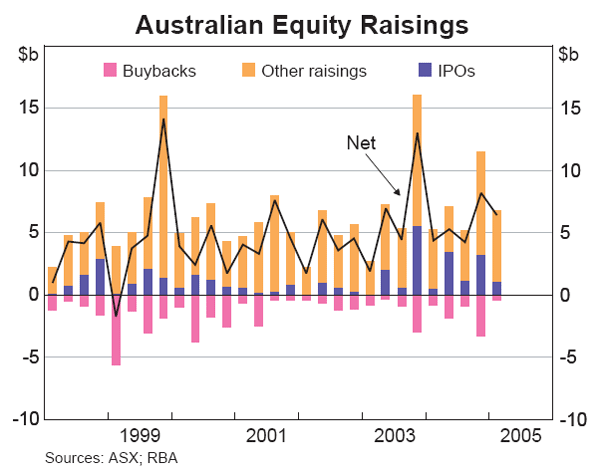
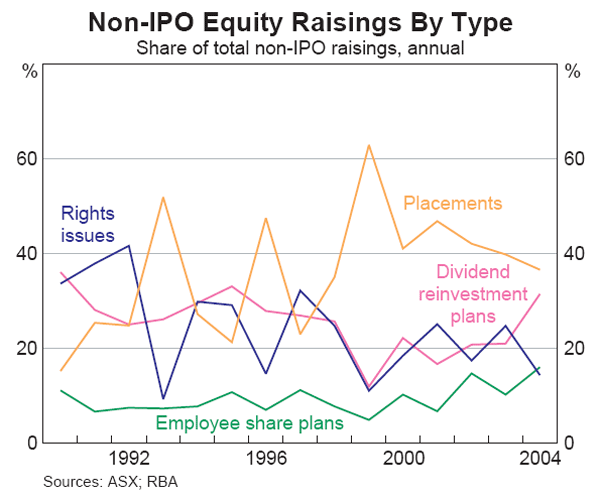
Box D: December Half 2004 Profit Results
The latest corporate profit reporting season was a strong one. Half-year profits of the 158 companies in the ASX 200 index that reported for the half year to December 2004 amounted to $29 billion, 91 per cent higher than in the corresponding period of the previous year (Graph D1). Underlying profits – which exclude significant items such as write-downs – rose by 38 per cent to $25 billion.
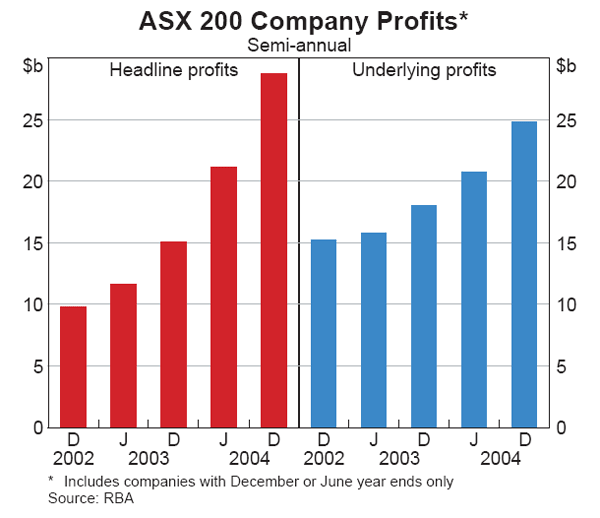
The growth in underlying profits was broad-based, with 80 per cent of individual companies and nine of the ten broad industry sectors recording an increase in underlying profits (Graph D2). The strongest growth was from companies in the materials sector, whose profits rose by 80 per cent. This was particularly driven by mining companies, whose profits almost doubled from the December half of 2003, benefiting from higher commodity prices and increased production.
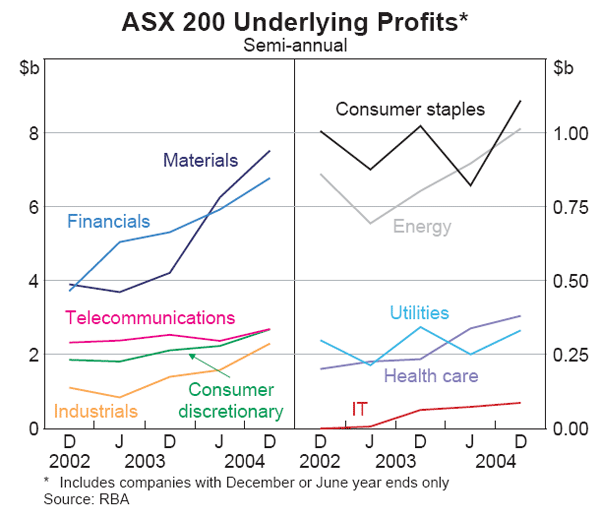
Aggregate profits were roughly 5 per cent above analysts' expectations, with 70 per cent of individual companies reporting profits that were ahead of expectations. Over the course of the reporting season, market analysts revised up their earnings forecasts for the 2004/05 and 2005/06 financial years. Forecasts of earnings growth for the current financial year were revised up by around 4 percentage points to 36 per cent, while forecasts for growth in 2005/06 were revised up slightly to 9 per cent. The mining industry experienced the largest upward revisions to earnings forecasts, with market analysts expecting profitability to remain high as a result of continued strong demand for commodities.
Growth in listed companies' underlying profits of 38 per cent was much faster than the economy-wide measure of profits from the national accounts – gross operating surplus (GOS) – which was up by 6 per cent in the December half year compared with the corresponding period of 2003. This difference is partly due to differences in the treatment of specific components of earnings such as interest, tax and depreciation, and in company coverage. GOS includes unlisted Australian companies and the domestic subsidiaries of non-resident companies, and excludes offshore subsidiaries of Australian companies. As a result, mining and financials companies, which both reported strong profit growth, account for a much larger share of listed companies' profits than of GOS.
Financial Conditions
Financial conditions are unlikely to be constraining economic activity, despite the increase in the cash rate following the March Board meeting. The nominal and real cash rates are now both close to their average levels of the past decade. Most lenders passed on the March increase in the nominal cash rate in full to housing and business lending rates (Graph 52). Nevertheless, banks' standard variable home loan interest rates remain slightly below their average of the past decade, reflecting some compression in margins during this period. In addition, as more borrowers turn to non-bank lenders or take advantage of products with discounted rates, the gap between indicator rates and effective housing interest rates has widened (Graph 53). For businesses, indicator interest rates have returned to near their historical average, but there is evidence that actual interest rates paid have fallen relative to indicator rates. This implies that the cost of intermediated funds to businesses remains low by historical standards.

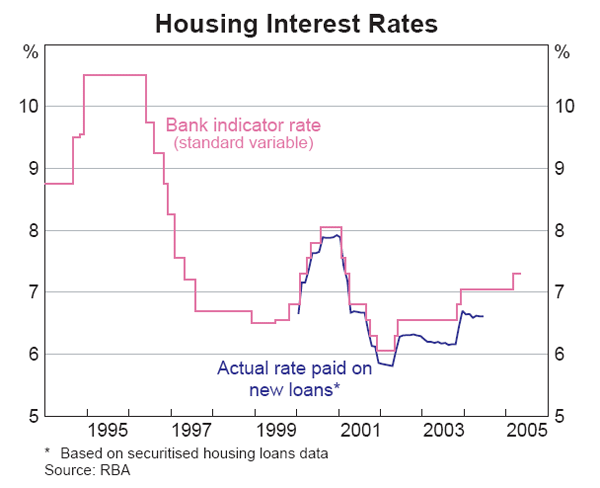
Bond yields are currently slightly below the cash rate, and this inversion of the yield curve would normally indicate that the current policy setting was viewed by the market as being relatively tight. However, bond yields have been mostly driven by US developments, where bond yields appear unusually low against a background of strong growth, rising inflation and increasing short-term interest rates. Chairman Greenspan has recently described the low levels of bond yields in the US as a ‘conundrum’.
The current level of interest rates does not appear to be constraining demand for credit. While total credit growth moderated during 2004, it has now stabilised at around 12–13 per cent (Graph 54). This is still higher than the average pace over the past decade, which itself was a period of rapid growth in credit in comparison with nominal GDP.
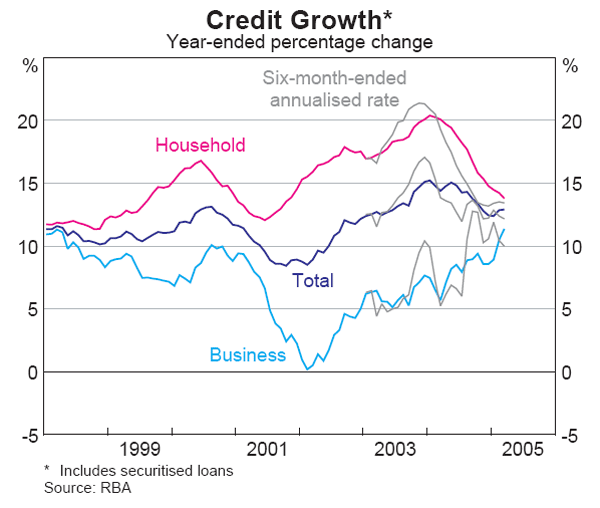
Household credit expanded at an annual rate of around 13½ per cent over the six months to March, which is close to the rate recorded in the previous six-month period, but well down from the peak rates seen in 2003. This slowing and subsequent stabilisation was driven by the housing credit component, which expanded at an annual rate of around 13 per cent over the six months to March (Table 12). In contrast, personal credit growth has been stronger, driven by a pick-up in fixed-term lending.
| Six-month-annualised | Year-ended March 2005 |
|||
|---|---|---|---|---|
| March 2004 | September 2004 | March 2005 | ||
| Total credit | 13.9 | 13.7 | 12.2 | 12.9 |
| Household | 19.3 | 14.2 | 13.4 | 13.8 |
| – Housing | 20.6 | 14.3 | 12.9 | 13.6 |
| – Personal | 12.8 | 13.8 | 16.6 | 15.2 |
| Business | 5.2 | 12.8 | 10.0 | 11.4 |
| Broad money | 11.2 | 7.7 | 8.8 | 8.2 |
|
Source: RBA |
||||
Business credit growth has also been strong. The year-ended rate has risen to 11½ per cent, its highest rate in seven years. The level of monthly business loan approvals remains high, despite having fallen from its peak in September 2004, which points to solid ongoing business credit growth. When the recent strength in capital market raisings is also considered, it is evident that businesses continue to have access to ample external finance.
The Australian dollar has appreciated modestly over the past few months; in real trade-weighted terms, in early May it was at a level similar to its most recent quarterly peak early in 2004, around 13 per cent above its post-float average. At this level the exchange rate may be constraining activity for some exporting and import-competing firms, particularly in manufacturing and services. On the other hand, for resource producers, production will be highly profitable at current exchange rates, given developments in resource prices. Relative to the terms of trade, the real exchange rate does not appear to be unusually high. As the Bank has noted elsewhere, the rise in the terms of trade is likely to be quite expansionary for the economy over the coming year or more.
Inflation Trends and Prospects
Recent developments in inflation
The Consumer Price Index (CPI) rose by 0.7 per cent in the March quarter to be 2.4 per cent higher over the year (Table 13, Graph 55). The most significant contributions to the quarterly increase were made by seasonal price increases for education and pharmaceuticals, and ongoing strength in house purchase costs. Offsetting these rises was a fall in petrol prices resulting from a temporary easing in world crude oil prices, and a fall in motor vehicle prices related to tariff cuts in January 2005. The Bank's assessment is that the underlying rate of inflation over the year to the March quarter is close to the headline CPI rate. This assessment is based on a range of underlying measures, including statistical measures that draw on the distribution of year-ended price changes.
| Quarterly | Year-ended | ||||
|---|---|---|---|---|---|
| December quarter 2004 |
March quarter 2005 |
December quarter 2004 |
March quarter 2005 |
||
| CPI | 0.8 | 0.7 | 2.6 | 2.4 | |
| – Tradables | 0.6 | −0.1 | 1.4 | 0.6 | |
| – Tradables (excluding food and petrol) | 0.0 | −0.1 | −0.6 | −0.2 | |
| – Non-tradables | 0.8 | 1.3 | 3.5 | 3.7 | |
| Underlying measures | |||||
| Weighted median | 0.6 | 0.5 | 2.4 | 2.2 | |
| Trimmed mean | 0.7 | 0.5 | 2.4 | 2.3 | |
| CPI excluding petrol | 0.7 | 0.8 | 2.0 | 2.0 | |
| CPI excluding volatile items(a) | 0.6 | 0.8 | 2.1 | 2.4 | |
|
(a) Volatile items are fruit, vegetables and petrol Sources: ABS; RBA |
|||||
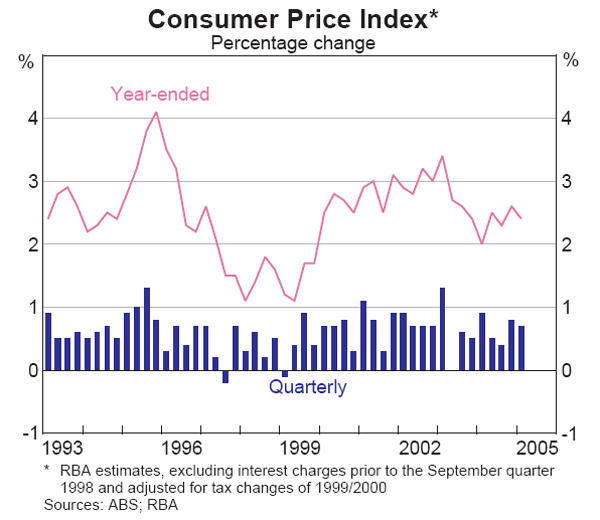
The gap between inflation of tradable and non-tradable items persists, though it narrowed further in the quarter. Tradables prices increased by 0.6 per cent over the year to the March quarter. Abstracting from food and petrol prices, tradables prices were only slightly lower than a year ago, confirming that the dampening effect of the large exchange rate appreciation in 2002 and 2003 has now largely passed (Graph 56). Non-tradables price inflation has been significantly stronger than tradables inflation for some time, and picked up slightly to 3.7 per cent over the year to the March quarter. Non-tradables price inflation continues to be affected by strength in house purchase costs, which increased by 5½ per cent over the year; this increase is the result of rising costs of skilled labour and materials.
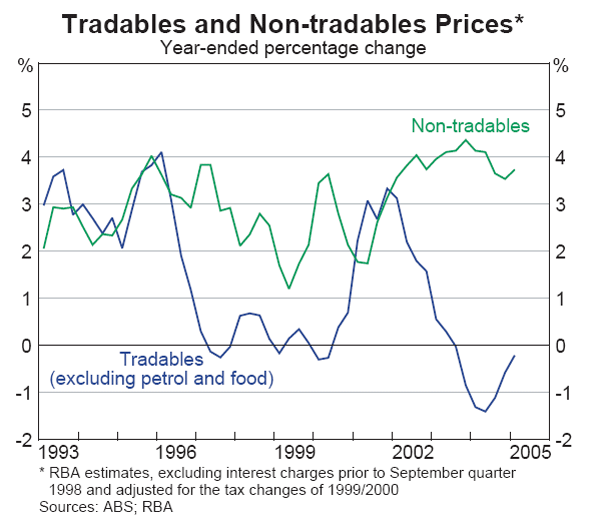
Producer prices
Producer price data suggest that upstream inflationary pressures eased in the March quarter; this followed three quarters of strong growth in a broad range of output prices. The recent easing in producer price inflation was evident at all stages of production, and for both imported and domestic items (Table 14). The fall in crude oil prices in the March quarter played an important role in this outcome.
| Year to March quarter 2004 |
Year to March quarter 2005 |
March quarter 2005 |
|
|---|---|---|---|
| Preliminary | −2.7 | 5.7 | −0.7 |
| – Domestically produced | −0.5 | 4.9 | −0.4 |
| – Imported | −15.8 | 11.7 | −2.6 |
| – Excluding oil | −1.1 | 4.4 | 0.2 |
| Intermediate | −2.3 | 4.4 | −0.5 |
| – Domestically produced | 0.0 | 4.0 | −0.3 |
| – Imported | −15.7 | 7.0 | −2.2 |
| – Excluding oil | −1.3 | 3.6 | 0.1 |
| Final(a) | 0.9 | 3.7 | 0.0 |
| – Domestically produced | 4.1 | 4.4 | 0.4 |
| – Imported | −13.6 | −0.7 | −2.2 |
| – Excluding oil | 1.1 | 3.4 | 0.3 |
|
(a) Excluding exports Source: ABS |
|||
The mild appreciation in the exchange rate over the March quarter also contributed to falls in import prices at all stages of production. However, as with the tradables component of the CPI, the year-ended change in prices of imported items provides further evidence that the downward price pressure from the sharp appreciation of 2002 and 2003 has continued to wane (Graph 57). Aside from exchange rate and oil-related price falls, the most significant price declines for imported items were for industrial and electronic machinery & equipment and motor vehicles & parts. Partly offsetting these effects, higher world prices were apparent for a range of raw materials, including plastics and iron & steel manufactures.
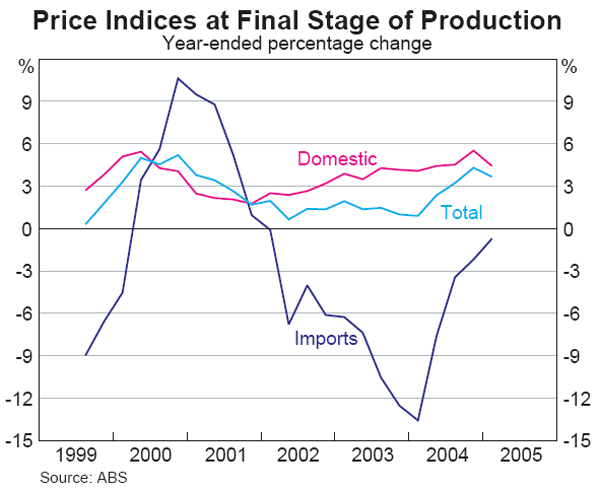
Abstracting from oil-related price falls, domestic prices at the final stage of production increased by 0.7 per cent in the March quarter, underpinned by ongoing strength in building construction prices. Construction prices increased by 1.8 per cent in the March quarter and by 7.6 per cent over the year, with prices for non-residential construction running ahead of those for house building. Price pressures in the construction industry were stronger, amid reports of increasing labour and material input costs, in particular for steel and cement. Domestic prices at earlier stages of production, excluding oil-related price falls, increased modestly in the quarter.
Labour costs
Most indicators of aggregate wage growth remained firm in the December quarter, though there are few signs that the strong wage pressures evident in some sectors are becoming generalised. The Wage Price Index (WPI) grew by 1.0 per cent in the December quarter, a slightly larger increase than had been seen in recent quarters, with the index 3.6 per cent higher over the year (Graph 58). The average annualised wage increase (AAWI) in federal enterprise bargaining agreements registered in the December quarter remained in line with that seen over the past year at 4.0 per cent. The AAWI in all current federal agreements was also little changed in the quarter at 4.0 per cent. Other official labour cost data based on wage-bill measures, such as average weekly ordinary time earnings and average earnings from the national accounts, paint a similar picture, identifying firm wage outcomes but giving little indication of an acceleration of aggregate wages growth. Furthermore, the NAB quarterly business survey reported that year-ended growth in labour costs was essentially unchanged in March, and is expected to remain roughly constant in the June quarter.
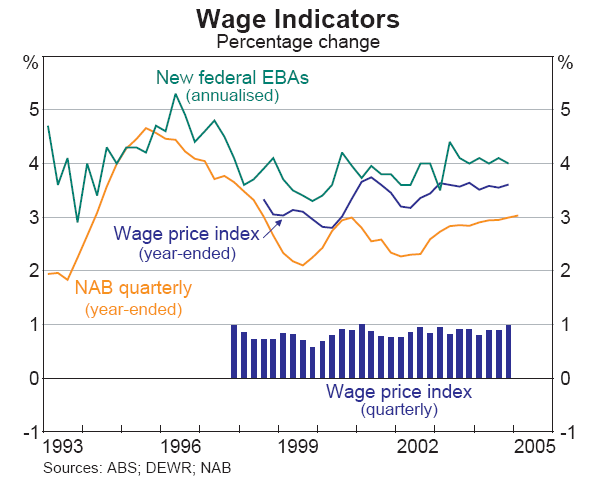
While aggregate wage growth remains contained, official wage statistics and liaison have pointed to greater wage pressures in industries facing strong demand, such as construction and mining (Graph 59). Wage growth in the construction sector, as measured by the WPI, picked up to 5.5 per cent over the year to December. Official wage data also show ongoing strength in public-sector wage growth and a significant rise in wage growth in education: the WPI measure of public-sector wage growth increased by 4.2 per cent over the year to December, almost 1 percentage point higher than the equivalent private-sector wage series. In addition, liaison suggests that there is wage pressure in some occupations in the business services sector, particularly accountancy, although it is not possible to distinguish these groups in the official wage statistics. Wage rises for other occupations (such as childcare and healthcare) have also been achieved recently by employees seeking to maintain wage relativities with other groups.

Business surveys and liaison continue to indicate generalised difficulties in finding suitable labour (Graph 60). Consistent with these labour shortages, firms are reportedly increasing the frequency of their salary reviews and more actively using non-wage remuneration, such as bonus payments and more generous leave provisions, to attract and retain employees. Firms are also encountering rapid growth in subcontractor rates and training costs. Consequently, there may be greater labour cost pressures than are evident in narrower official wage measures which do not capture these forms of payment. Unit labour costs, which measure total (wage and non-wage) labour costs per unit of output, grew by 3.4 per cent over the year to December, above the average of the past five years. This mostly reflects an apparent slowing in productivity growth, as output growth has eased but employment growth has remained strong. It remains to be seen if the consequent rise in unit labour costs is a precursor to greater inflationary pressures or if it will be absorbed into profit margins.
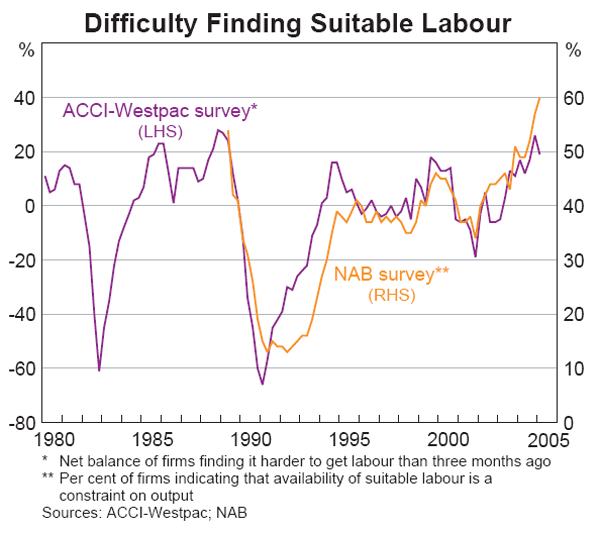
Inflation expectations
Business surveys provide mixed signals about near-term inflationary pressures. The ACCI-Westpac survey reported falls in the net balances of firms increasing selling prices in the March quarter and expecting to raise prices in coming months. According to the NAB survey, product price inflation fell in the March quarter and is expected to be broadly steady in the June quarter. However, the survey reported that retail price inflation is expected to increase in the June quarter, having been steady in the March quarter.
Other indicators suggest that inflation is expected to rise modestly over the next two years. The Bank's survey of market economists, conducted following the release of the March quarter CPI, showed that the median forecast for CPI inflation for the year to June 2005 was 2.7 per cent; this was higher than expected at the time of the previous survey owing to recent developments in oil prices. A similar rate of inflation is now expected over the year to June 2006. Union officials expect CPI inflation to be 2.6 per over the year to June before drifting up to 2.8 per cent by mid 2006 (Table 15).
| Year to June 2005 | Year to June 2006 | |||||
|---|---|---|---|---|---|---|
| November 2004 |
February 2005 |
May 2005 |
February 2005 |
May 2005 |
||
| Market economists(a) | 2.4 | 2.4 | 2.7 | 2.6 | 2.6 | |
| Union officials(b) | 3.0 | 2.8 | 2.6 | 3.0 | 2.8 | |
| (a) RBA survey (b) ACIRRT survey |
||||||
Financial market participants' medium-term inflation expectations, calculated as the difference between nominal and indexed bond yields, have changed little since the last Statement, to be around 2.7 per cent. The median inflation expectation of consumers, as reported in the Melbourne Institute survey, was 4.6 per cent in April, up sharply from the previous month, but around its level of the past five years.
Inflation outlook
CPI inflation was 2.4 per cent over the year to the March quarter, with this rate also a good gauge of the Bank's assessment of underlying inflationary pressure. The inflation outcome for the March quarter suggests that the economy has passed the low point for underlying inflation in the current cycle. This has come about because domestic inflationary pressures have remained firm, while the disinflationary effects of the large exchange rate appreciation in 2002 and 2003 have continued to wane. Looking ahead, underlying inflation is expected to rise modestly to a little over 2½ per cent during the course of 2005, and to 3 per cent by the end of 2006. This profile is broadly in line with that presented in the February Statement on Monetary Policy, though recent movements in world oil prices are likely to introduce a divergence between headline and underlying measures of inflation in the short term. In particular, following a quarter when falling petrol prices reduced inflation, the higher level of petrol prices in the first month of the June quarter suggests that a substantial contribution to the CPI is possible, which could take CPI inflation close to 3 per cent in the year to the June quarter.
While the central forecast for underlying inflation remains similar to that provided in February, the risks around this outlook now appear more evenly balanced, rather than on the upside as indicated in previous Statements. On the one hand, the ongoing evidence of tightness in the labour market suggests that growth in labour costs may pick up faster than is assumed in the current forecast. In addition, capacity constraints in some parts of the economy and strong global commodity prices could add to upstream price pressures, particularly if sustained strength in energy prices raises inflation expectations. However, given the possibility of some slowing in domestic demand, the risks from upstream costs appear to have moderated, with greater likelihood that any additional pressures might be absorbed into profit margins rather than passed through into consumer prices.
Footnotes Box A
Within the region, however, there have been some areas of strength. Exports have grown strongly in Germany, which has seen a more pronounced decline in its unit labour costs and faces limited competition for its exports from emerging Asian economies; in fact, Germany has also now overtaken the US to become the world's largest merchandise exporter. The euro area's import growth has been led by France and Spain, where domestic activity has been more buoyant. [1]
See the article on ‘Commodity Prices and the Terms of Trade’ in the RBA Bulletin, April 2005, for a more detailed discussion. [2]
Footnotes Box B
Although such a measure excludes inventories, interstate trade and international trade in services. [1]
Footnotes Box C
Direct investors are defined as foreign shareholders with at least a 10 per cent equity stake in the Australian company; all others are defined as portfolio investors. Dividend payments to all non-residents are included as debit items in the current account. In addition, retained earnings that accrue to direct investors appear in the balance of payments as notional dividend payments, along with an offsetting capital inflow item for the notional reinvestment of these earnings. [1]